Breaking with recent trends I was up – and out – very early on the Sunday morning, for I had a day trip planned! Whenever I’m in a new city I always try to get out of town for the day, to experience another part of the country. I’d done a fair bit of research before coming to Lisbon, and settled on spending a day in Sintra.
It’s a small town about a 50 minute train ride from Lisbon, and as I was to see for myself, it’s a very popular day trip destination for tourists, due to its numerous attractions.
I’d literally googled the life out of how to navigate the various attractions, buy tickets for them and get to them. Cars aren’t allowed in the centre of Sintra and car parking is really limited around attractions as well, so using public transport is by far the best way to go and get around once you get there.
I was under the misapprehension that Sintra wouldn’t be that busy as I was travelling off-season – in mid November. I was wrong.
Despite all my research, which mostly involved reading articles on this very helpful website over and over again, I would make several fatal errors during the day – mostly involving the bus that ploughs the tourist trail in the town. Read on for how not to do a day trip to Sintra!
Getting to Sintra
The day started off well. I stepped on to Avenida Liberdade at 7.20am and less than half an hour later was on the platform for the 7:50 train to Sintra.
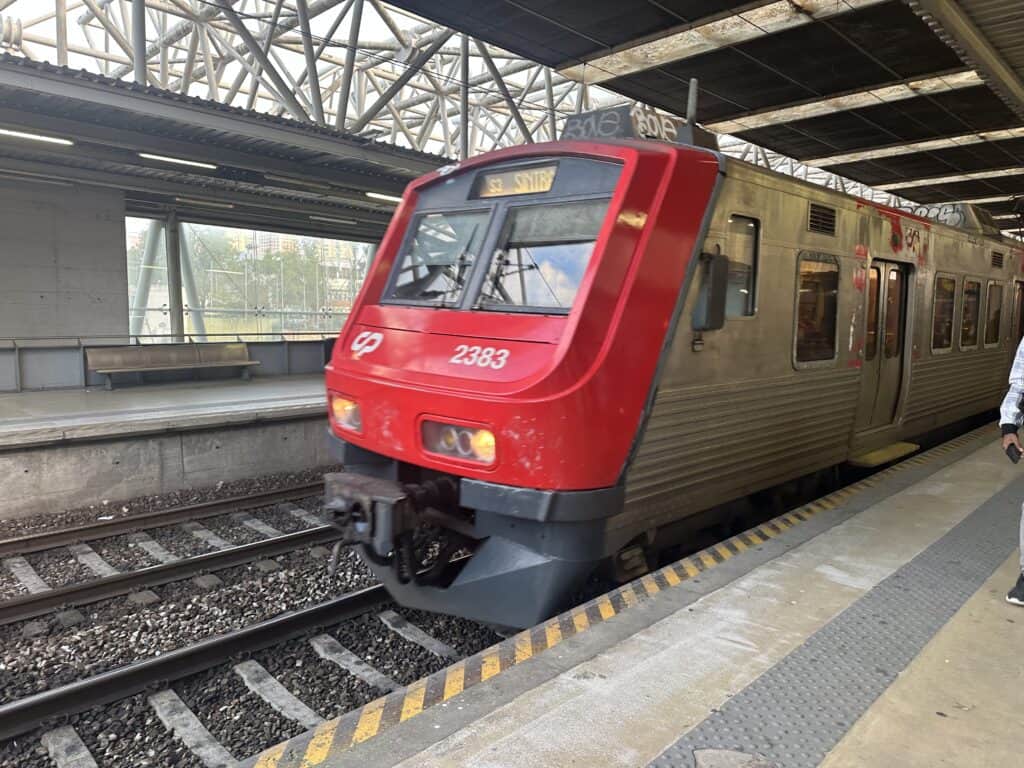
Onboard the train was an oasis of calm…
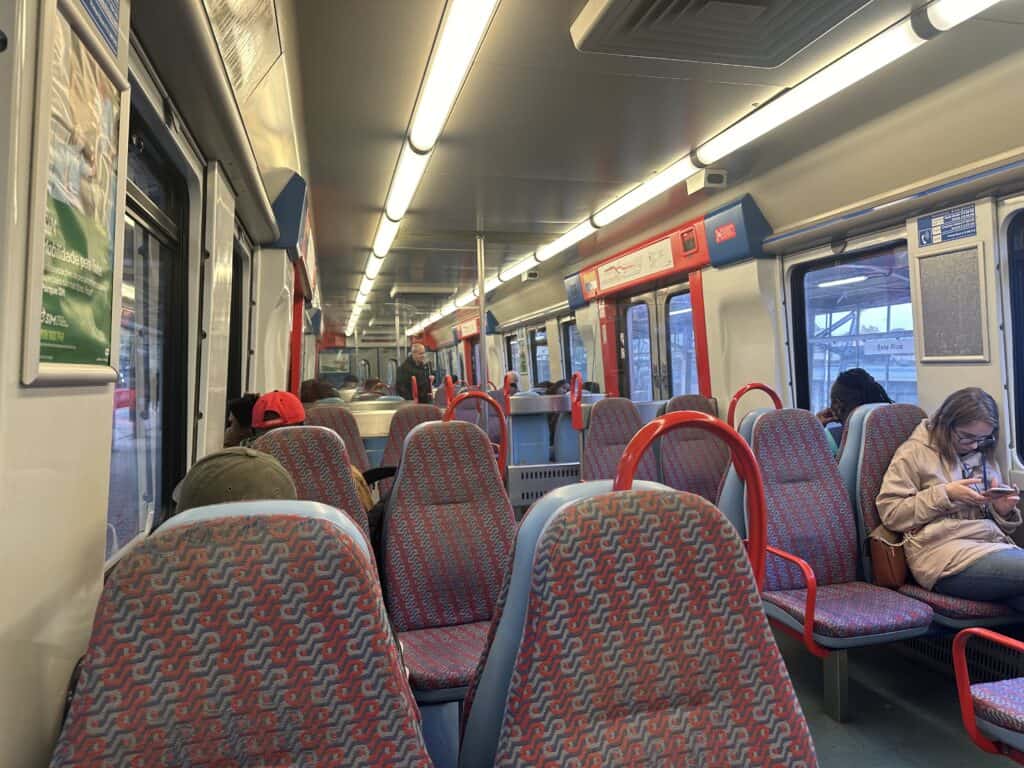
I just sat and watched Lisbon and countryside go by, and before I knew it I’d arrived to at one of the town’s picturesque railway stations. Note there are two stations in Sintra – if you’re going to the main attractions or town centre, you want to get off at the Sintra station, not the Portela de Sintra station.
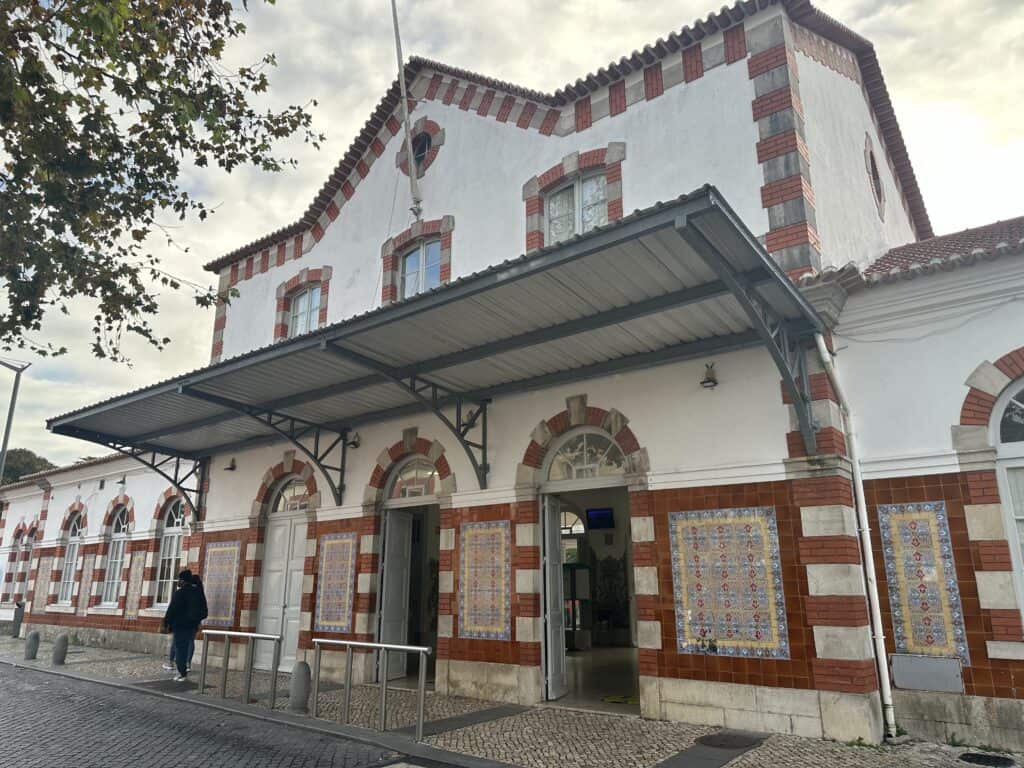
The streets were deserted. I was feeling very pleased with myself for coming off-season! I stepped into a little café…

…and got a coffee and then walked back across the road to the bus stop.
The 434 bus in Sintra
Sintra is steep, and the many attractions in the town are situated quite far from the train station, up very narrow and winding roads. Apart from an expensive tuk-tuk, getting the one bus that stops at tourist attractions is really your only option.
It leaves from outside the Sintra train station and runs on two different timetables – one for the high season and one of the low season. I was in plenty of time to catch the first bus of the day at 8.50am.
The bus is absolutely, 100% aimed at tourists. And feels like a complete rip off. There’s only one operator running on the route, and the prices seem to be pitched to make as much money as possible. I had researched this and was well prepared – I’d read the bus driver would try and sell you the 24 hours hop-on-hop-off option ticket which is €13,50 in low season, and which appears to be €15 in high season (so they can maximise profits I guess!)
I’d also read, however, about the Pena Round Trip Ticket which would be a return ticket to my first destination, Pena Palace. It’s only €7,60 (it seems to have since gone up to €8.40). As I was planning on walking anywhere else after my trip to Pena Palace and returning to the town centre, I was going to buy that. I know there’s only €5 in it but please remember I am Scottish and have to live up to my country’s reputation for being tight-fisted!
The bus driver wouldn’t sell the round trip ticket to me.
He insisted that ticket was only available to groups and I had to buy the €13,50 ticket. I tried and tried to protest telling him it was on their website, but he wouldn’t budge. It LITERALLY GAVE ME THE RAGE! So I decided to just buy a single ticket, for €4,10. I was absolutely determined, at all costs, to avoid the rip off €13,50 ticket!
I boarded the bus, and took a seat. With only five minutes to go there were only about four of us on board, so felt pretty chilled.
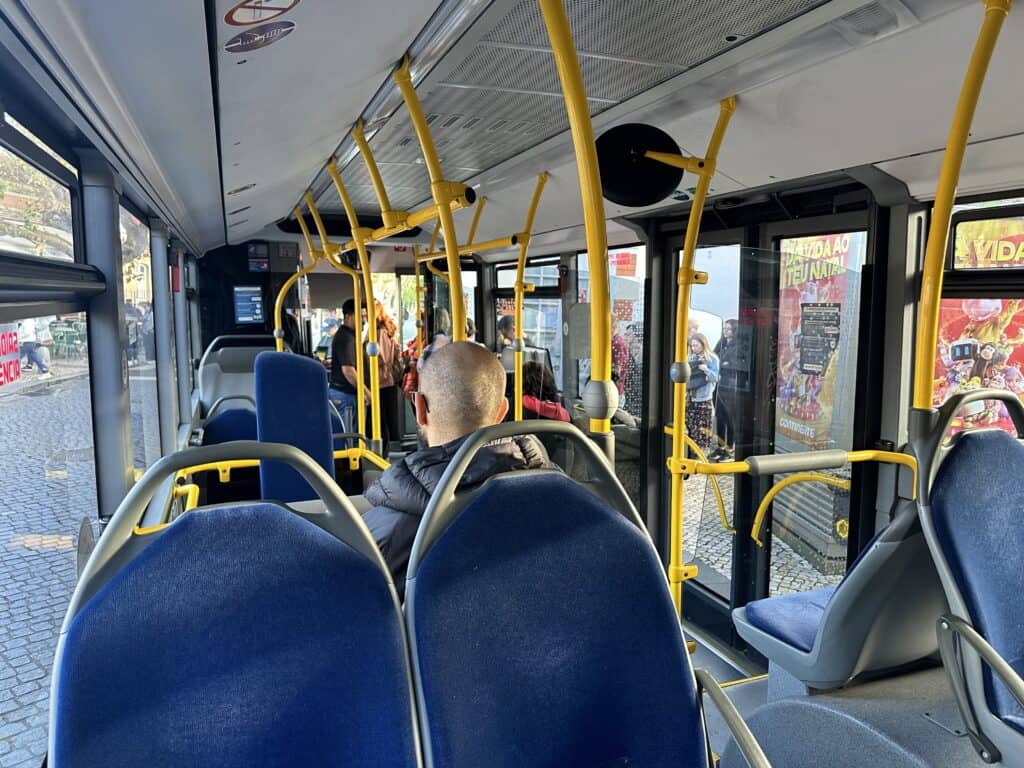
…and then another train pulled in to the station.
Tourist after tourist boarded the bus which before long was absolutely rammed! It trundled away from the station and started snaking its way up zig-zag bends towards Pena Palace. Mass confusion seemed to rein on board, with people attempting to get off at nearly every stop thinking they’d arrived at the palace. After about twenty minutes we did arrive at the main entrance gate.
Pena Palace
The National Palace of Pena was created by Ferdinand II – who married Portugal’s Queen Maria II in 1836. He seems like he was quite the guy! He could speak German, Hungarian, French, English, Spanish, Italian and Portuguese, which is a lot more impressive than my schoolboy french and basic Norwegian! He was an avid collector of art, and became known nationally as the King-Artist.
He acquired a former monastery in Sintra and the lands surrounding it and constructed a palace – what’s now known as Pena Palace. In the 85 hectares surrounding the palace he designed twisting paths to take visitors on a tour of small features and also planted tree species from every continent.
To me the thing that strikes you most about the palace is its colourful exterior.

Tickets to the palace are best purchased online, although the queue for tickets didn’t seem that bad to me – although perhaps that was just because I was on the first bus to arrive that day.
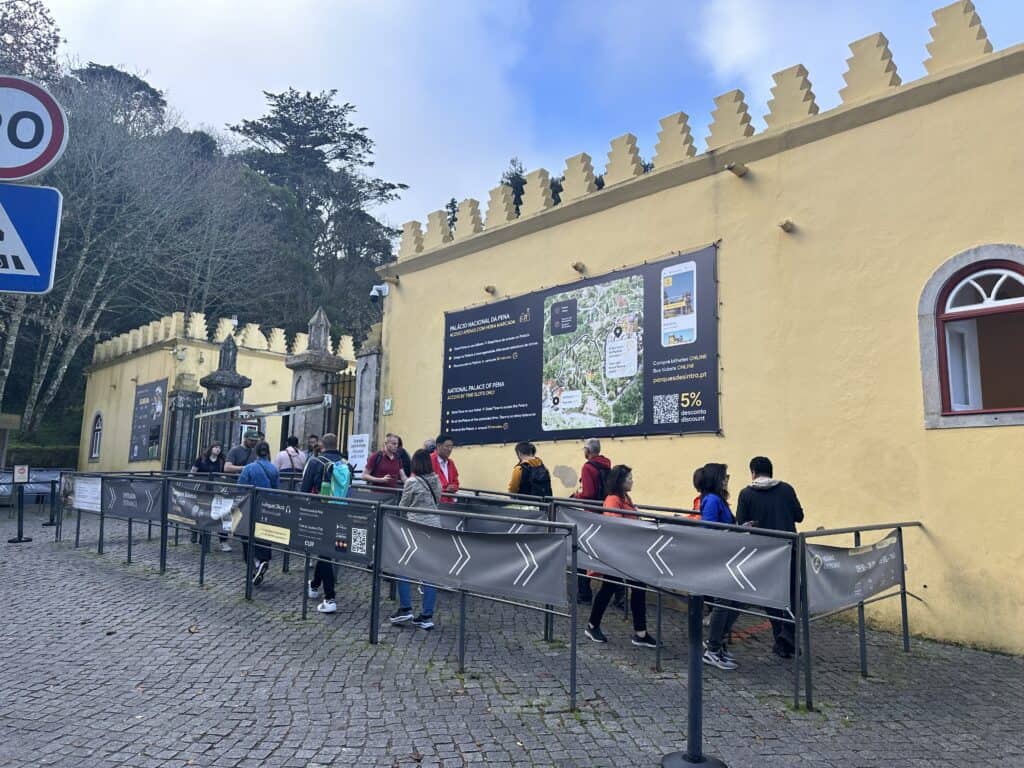
You buy your ticket against a specific time slot, and there are warnings aplenty that if you miss your slot you won’t be admitted!
After reading that it took about half an hour to walk from the entrance to the palace entry point, I’d booked a ticket for ten o’clock. I set off along one of Ferninand II’s paths…
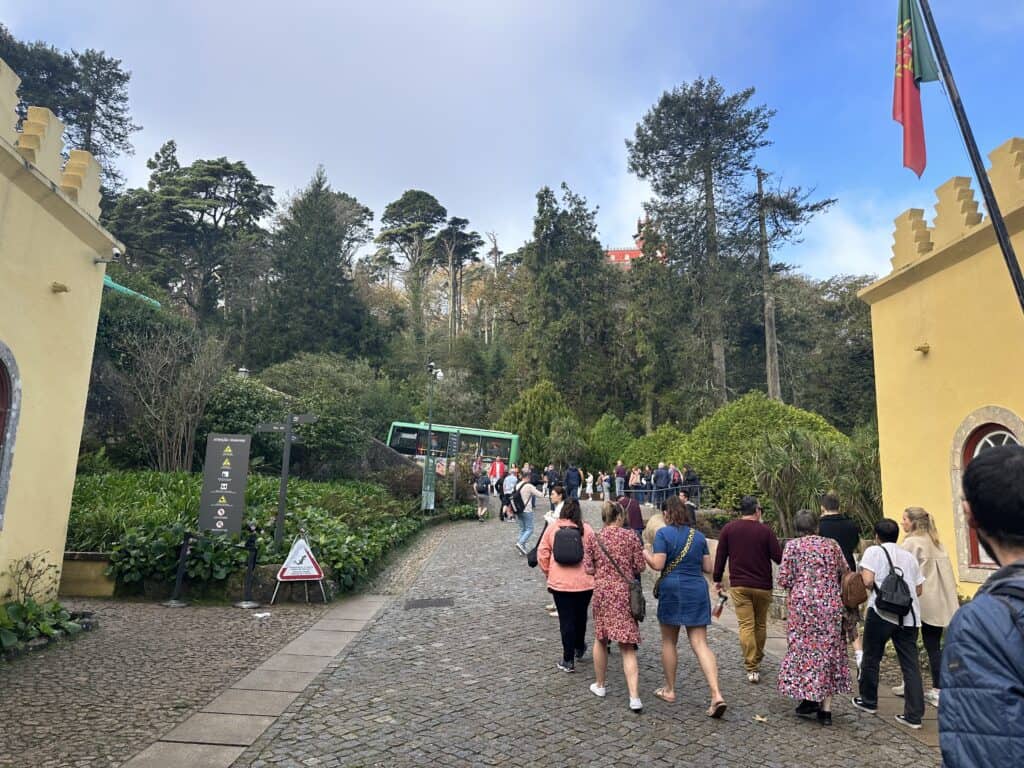
It took me ten minutes to reach the palace entrance! And I wasn’t walking that swiftly either. There was a sign directing me to join the 10am queue, so I stood there and gazed at the palace for half an hour.
All around me were people taking selfies! Literally every single person that came around the corner started pointing their phone in the sky and taking photo after photo as they moved their camera around. Then they’d turn it on themselves and take more. I do try to be a bit selective when taking photos so I don’t end up with thousands – trying to think back to the days when you had to buy film and didn’t take a million shots of the same things! As I watched people taking photos of tree branches and rocks I couldn’t help thinking ‘will they ever really go back and look at them all’?
The palace did look pretty spectacular from my point in the queue (I think I was third) – its walls were a warm yellow and terracotta colour…

And the entrance gateway was pretty neat too..
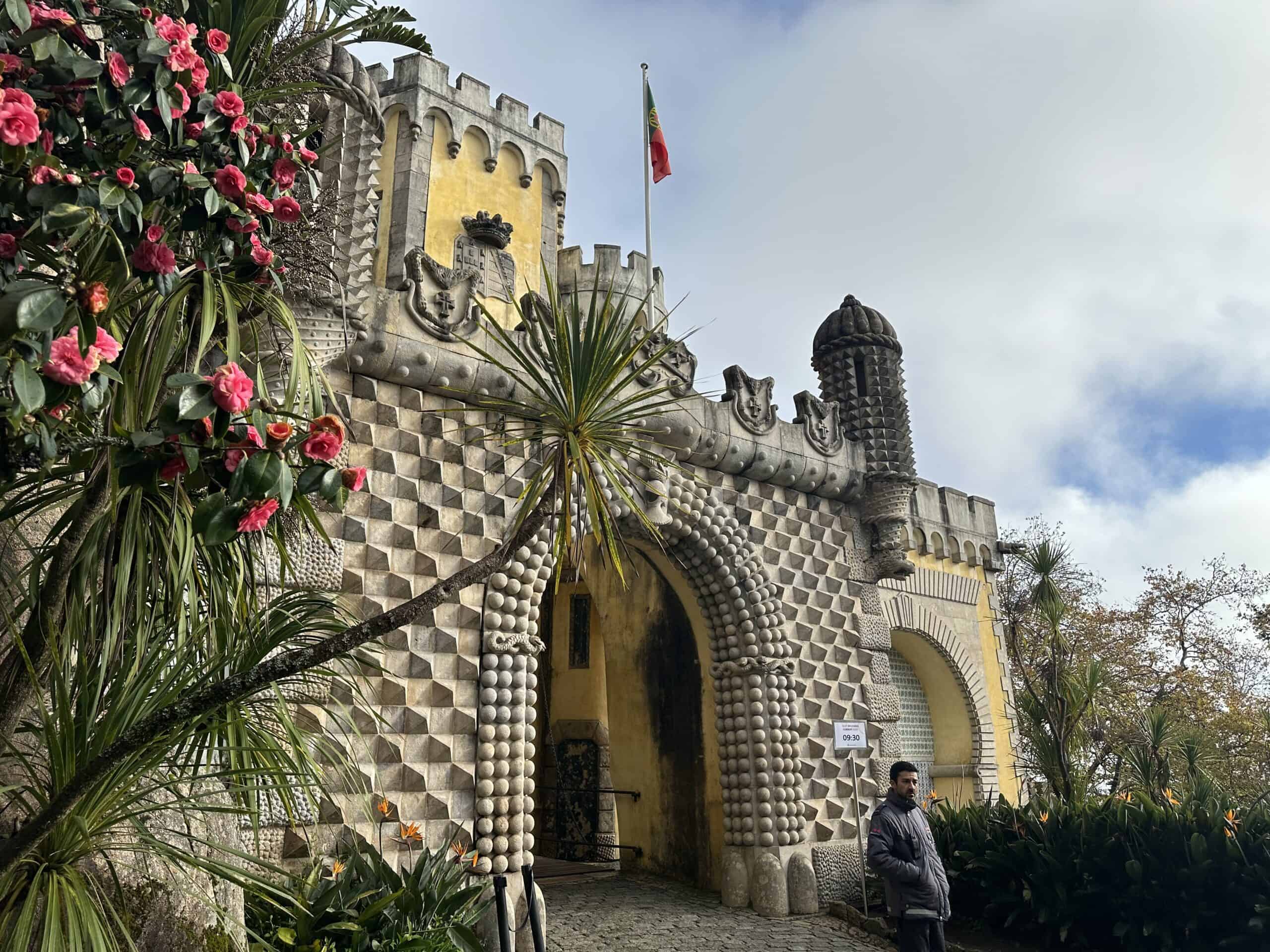
Eventually 10am arrived, and I got to cross the drawbridge and enter the palace.
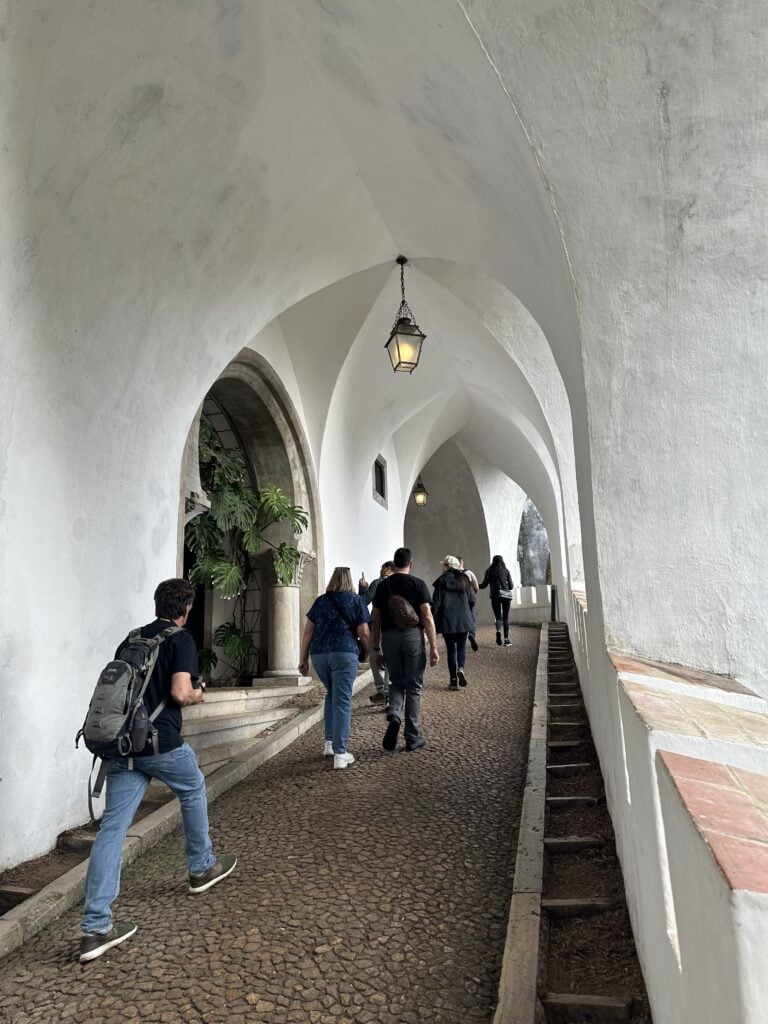
Despite it being off-season and pretty busy, as you made your way around the building you were kind of kept moving by the people coming behind you. Most of the time, though, I was able to stop and read and listen to the audio guide I downloaded on my phone for about £1. I’m not sure it would be such a relaxed experience if you came later in the day or in the height of summer!
One of the first features I walked through was the Manueline Cloister. It used to be the entrance for the monks in the monastery, so originally dated back to 1511. The walls were intricately decorated with colourful tiles. It felt like quite a Moorish kind of spot, and must have been a nice spot to relax under a summer sun.

As I made my way around the palace interior, stopping in most of the rooms, I was surprised by how different some of the art seemed – like this fresco (if that’s the right word) – it definitely wasn’t your normal kind of stuffy portraiture. This one – in the office of King Carlos was painted by the King – the grandson of Ferdinand, and depicts nymphs in the palace’s park.

There were also some of the best little ornaments I have seen in a long time. Take a look at this…

And this!

And perhaps my favourite… this…

Look at his face! A lot of the rooms featured incredible interiors. Just look at this bathroom…
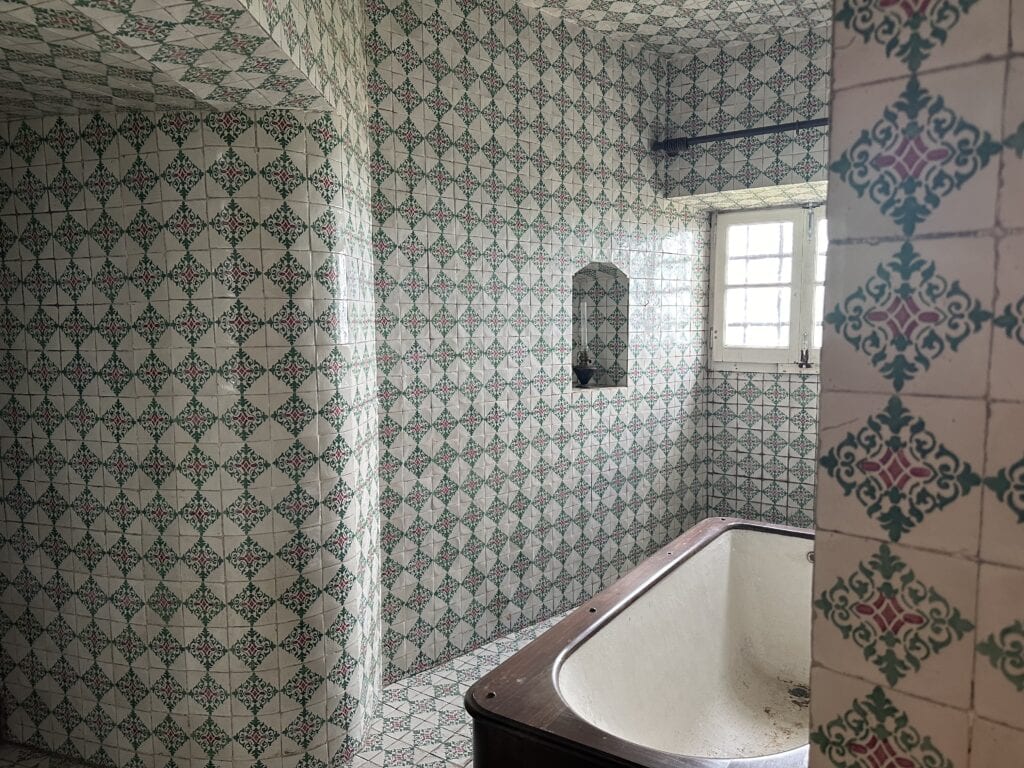
While Ferdinand II’s bedroom had a pretty jazzy painted plaster decor…

You probably wouldn’t want to be staring at that with a bad hangover though. These guys holding candelabras were pretty impressive too.
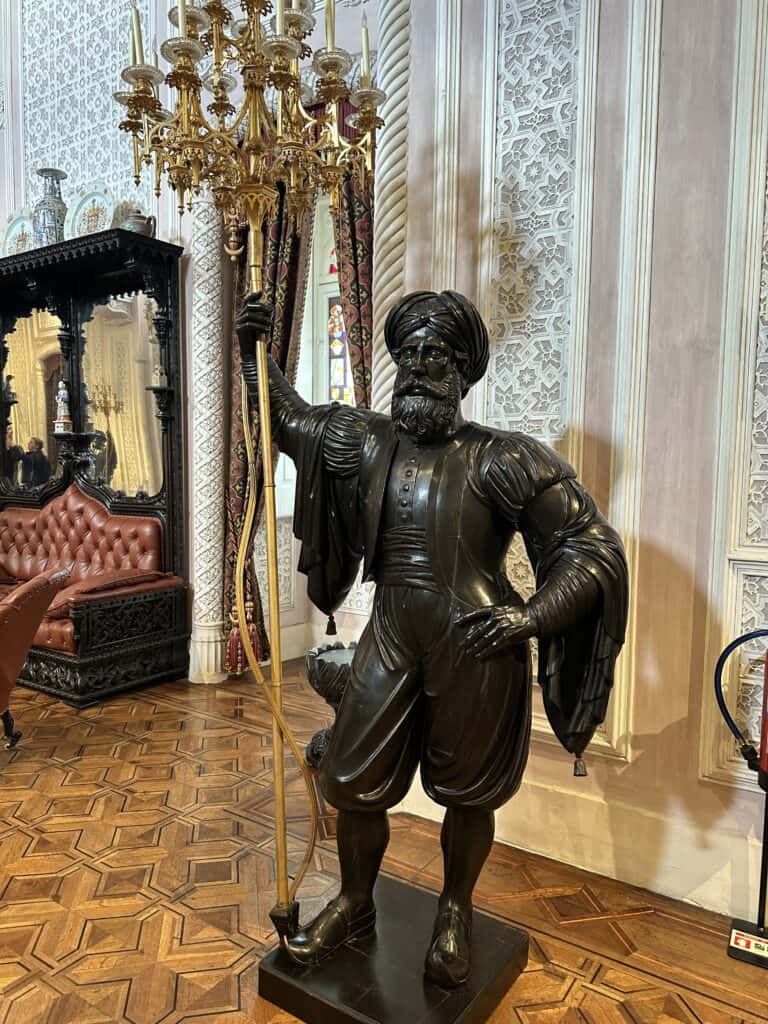
As I walked round I was reminded a bit of Neuschwanstein Castle which I’d visited on a trip to Munich a couple of years previously – the palace’s interiors were just a bit more bold, colourful and unique than anything you’d find in a grand building from a similar period in the UK.
After about forty five minutes I’d made my way around most of the palace, and arrived on a terrace which gave a great view of the palace.

Walking under a large archway took me to another terrace with a view of the countryside…
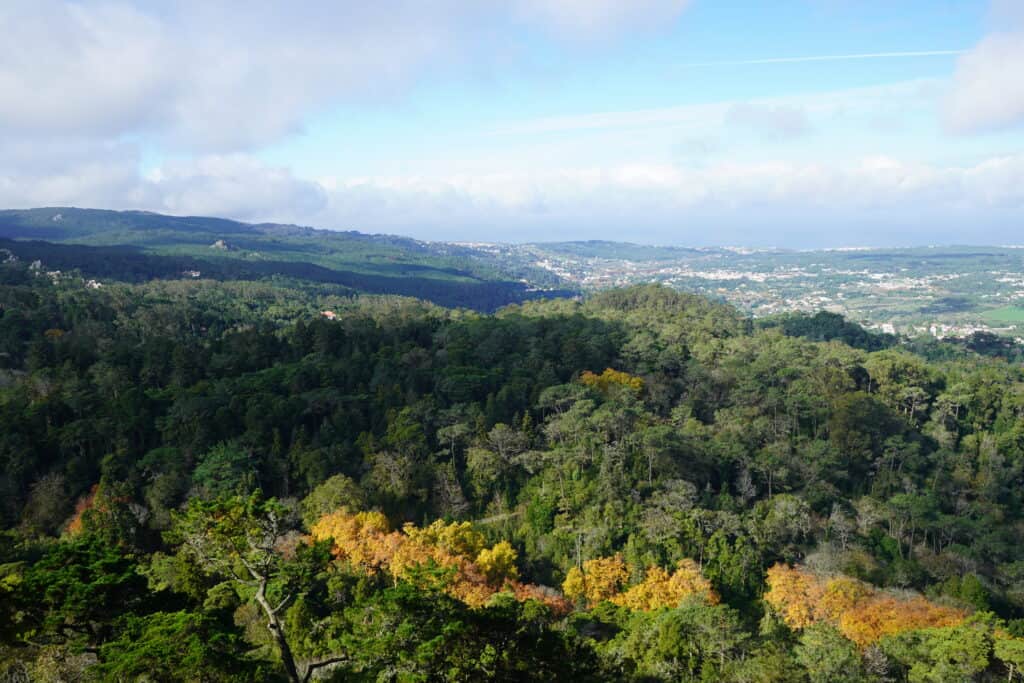
While a small staircase took you in to the palace’s small chapel…
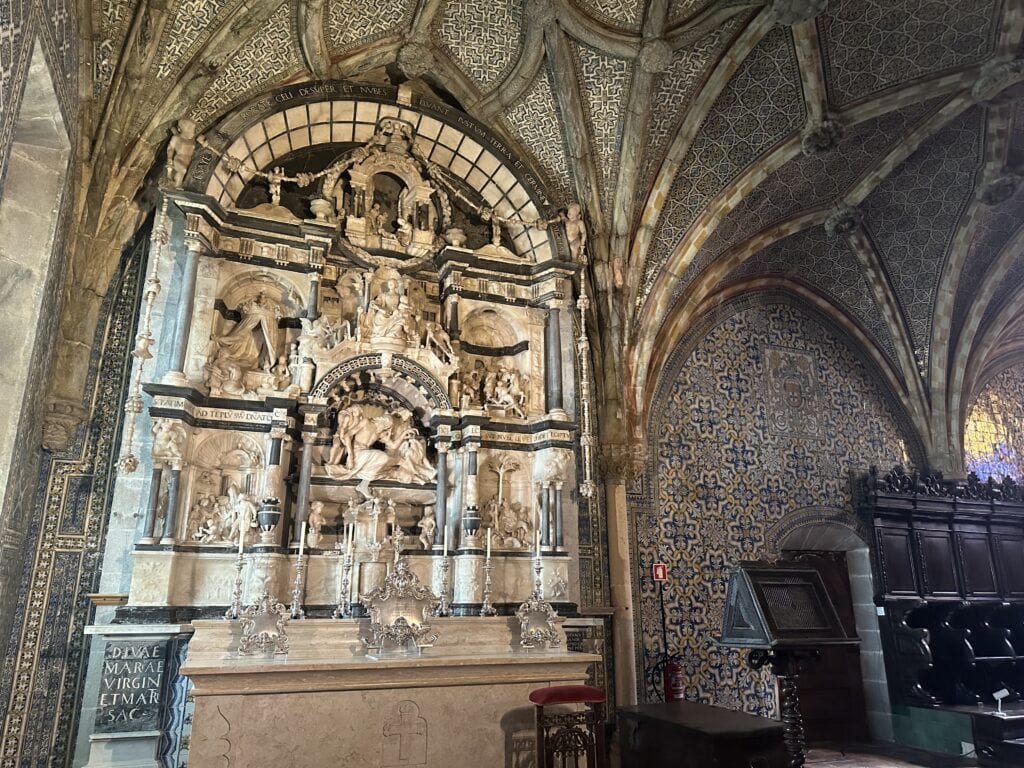
After a quick peek inside there, my tour of the palace was over. It hadn’t really taken that long but I’d really glad I’d made the trip to Sintra to see it. Although with the bus and everything it’s a bit of a schlepp, I’d enjoyed wandering around and left just… well… feeling a bit inspired and interested!
The Pena Gardens
I had a look in the shop just outside the palace entrance but was a bit disappointed in that there really wasn’t anything too interesting to pick up as a souvenir. As I made my way down the slope from the palace I decided I ought to have a wander around the palace gardens.
They’re dotted with little features and curiosities – things like grottos and resting places and so on. However I found it nearly impossible to navigate. I had a map, but it was impossible (for me anyway!) to work out where I was going.

I mean look at it! Paths run all over the place and it’s impossible to work out where you are at any one time. Very quickly after leaving the palace, the building falls completely out of sight, and you’re just surrounded by plants and trees. There was the very occasional signpost to some garden features, but most of the time I’d come to a fork in a path and have no idea which way to turn or which way I was headed.

I’d read that the best vantage point to give a view of the palace was a small mound called Alto De Chá or Tea Hill, but of course that wasn’t featured on the map. In the end I managed I used a combination of websites and Google Maps which featured some of the large features to figure out roughly where it was on the map I was holding, and then tried to head off in what I felt was potentially the right direction.
And would you believe… after twenty minutes of walking randomly and going with my gut feel… I came across this sign!
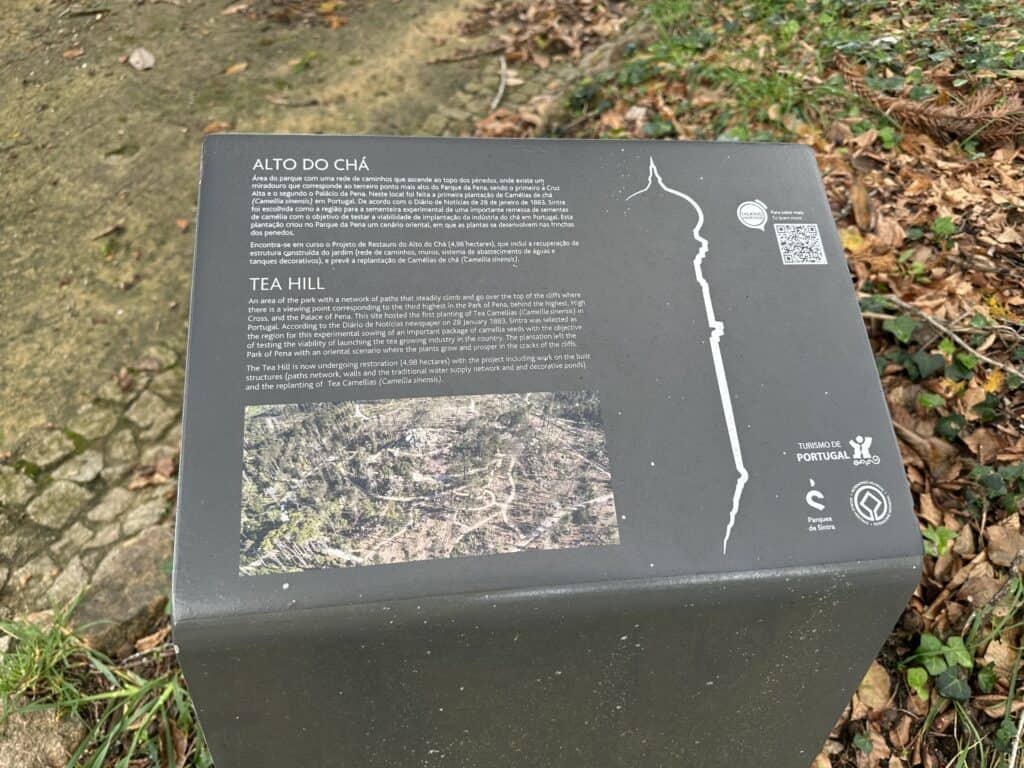
I’d arrived!
I walked around a little path around the hill.
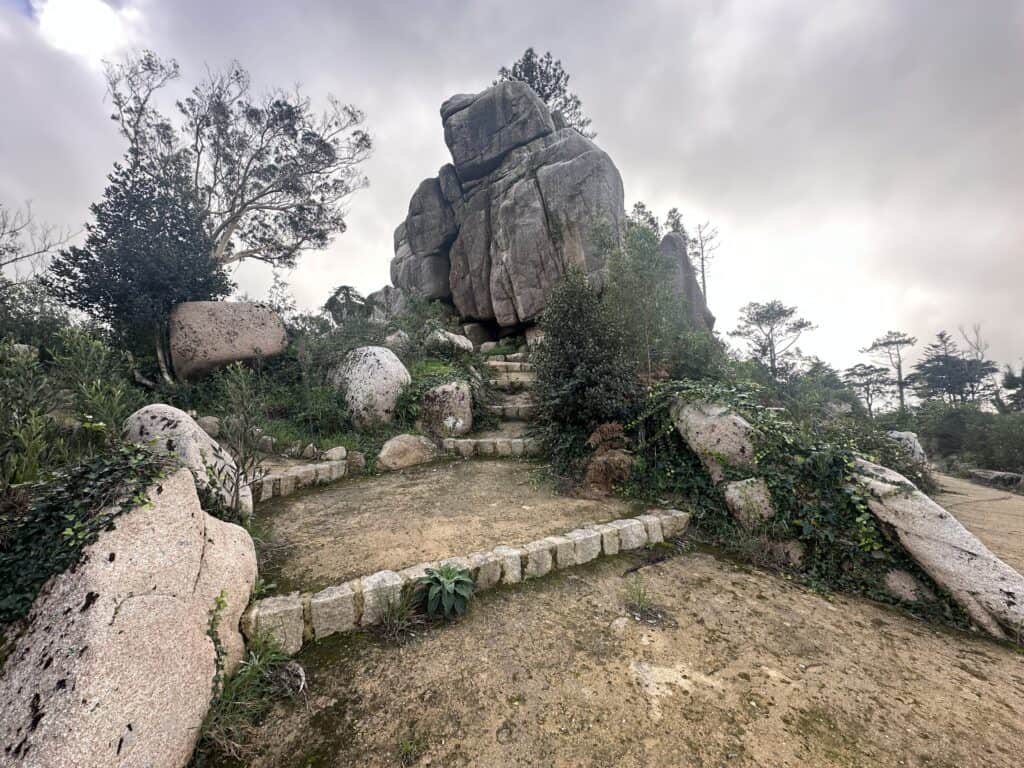
That soon turned into just a pile of rocks, and I clambered up them to get right to the top. Pena Palace looked absolutely miles away – I honestly didn’t feel like I’d walked that far, but I had!
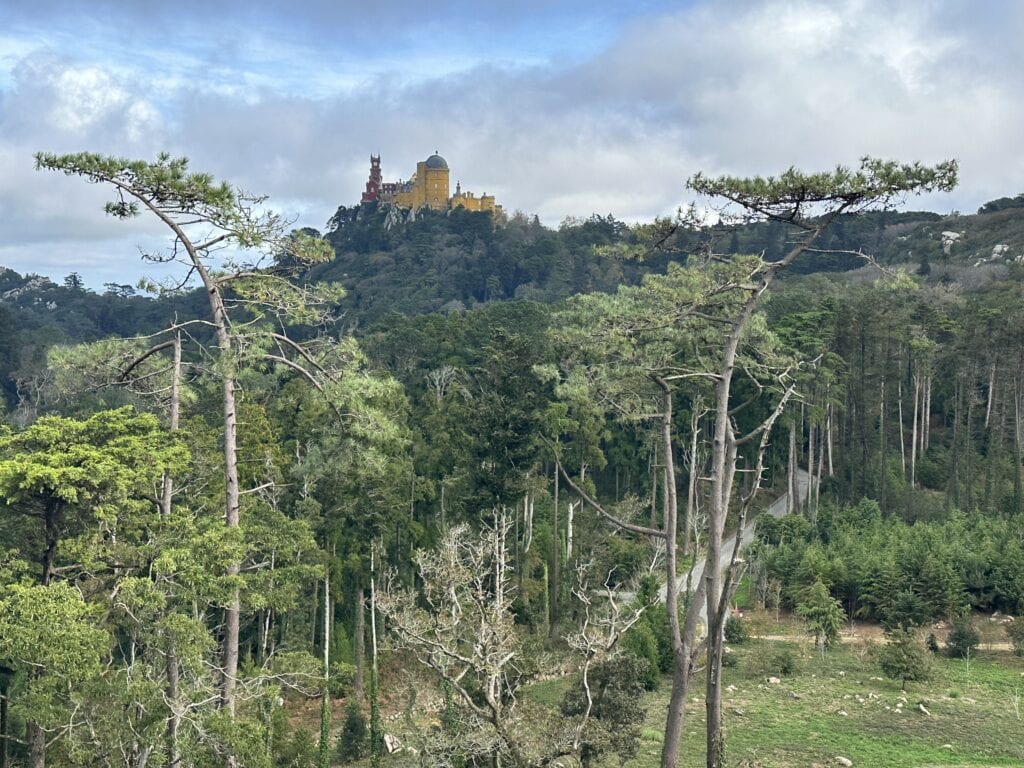
If you are reading this and planning a trip to Pena’s gardens I have marked on a map exactly where the hill is – hopefully clicking here will help you find it!
I took a few photos and then began my descent down Tea Hill. There was one more site I wanted to see in the gardens, and apparently it wasn’t too far from where I was.
I followed yet another twisting path and after not too long a walk arrived in a little clearing, where the Chalet of the Countess of Edla sat.

The Countess’s real name was Elise Frederick’s Hensler. An opera singer, she became King Ferdinand II’s second wife after he lost his first.
The Countess designed and planned the chalet, inspired by the alpine buildings that were in fashion at the time. After Ferdinand’s death, Elise sold Pena’s palace and park to the state, but kept the rights to use the chalet and its garden until 1904.
Sadly the chalet was destroyed by a fire in 1999. All of its interiors, roofs and part of the veranda were destroyed, leaving only the masonry. The fire burned for days before anyone noticed. When I read about it, I felt really sad, as it seemed like it had been a really loved romantic spot for the Countess and the King – one that she’d really poured her heart into designing.
After four years restoration work, the chalet reopened to the public in 2011.
After the crowds of the palace, it appeared few people make it out to the chalet – I was the only person there as I stepped inside.
While it looked perfect from the outside, inside the rooms were mostly bare, meaning it felt far from its prime. The walls however were beautifully decorated. The kitchen with a bright blue diamond motif…
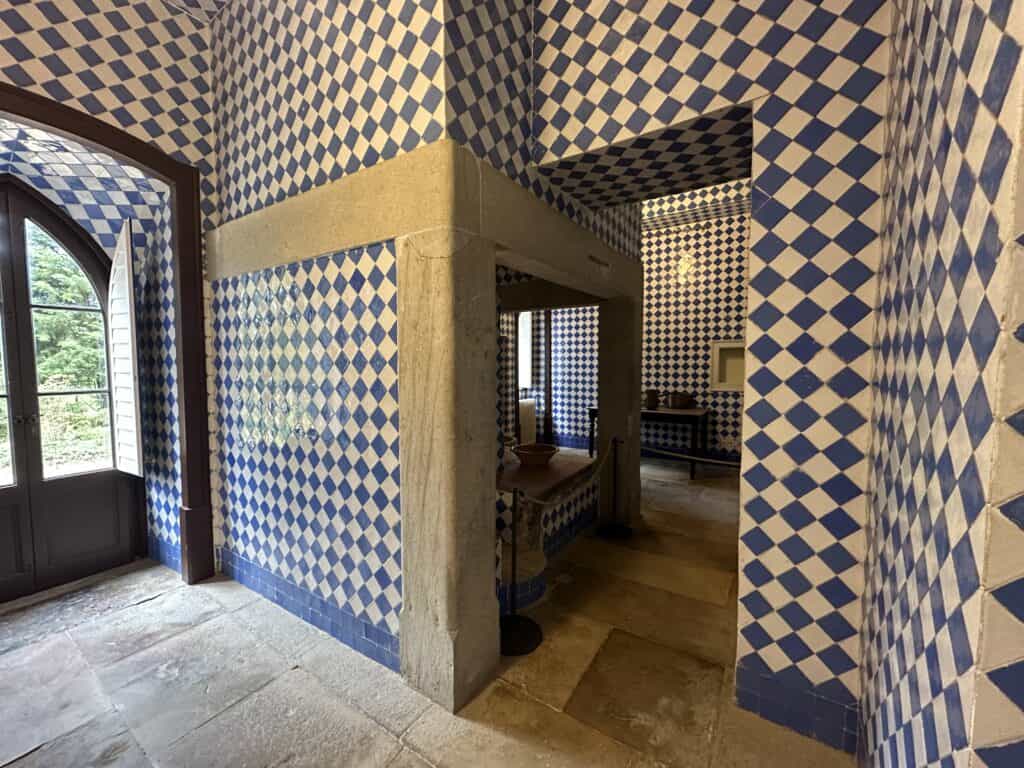
…while the hallways had amazingly intricate wood carvings – that’s quite a bannister!
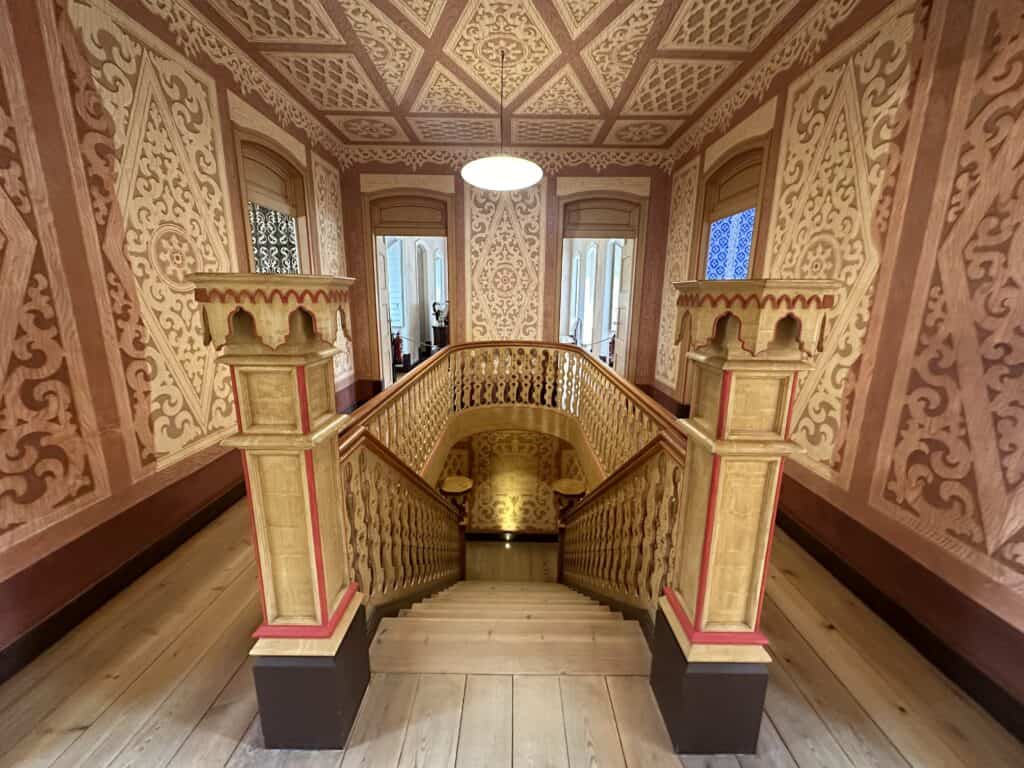
There were some small bits and bobs in the room like this picnic set made in Paris, but mostly there wasn’t really much to see inside.

Overall, it just felt a bit unloved and neglected, which I thought was a shame! Only one other person arrived while I was at the chalet, but I can imagine it probably gets more visitors in the summer peak periods.
Fatal bus error alert
Having seen everything I wanted to see in the gardens, the familiar task of trying to navigate the numerous paths began again.
I had company for around five minutes as a lady walked in front of me and I began to think I could just follow her but then decided that would be a bit weird – and probably scary for her!
My original plan had been to walk back to the palace and then follow the relatively straight forward path down to the main entrance. But a signpost I came across pointed to the palace being more than a kilometre away, so I decided instead to just walk down to where I thought the road might be.
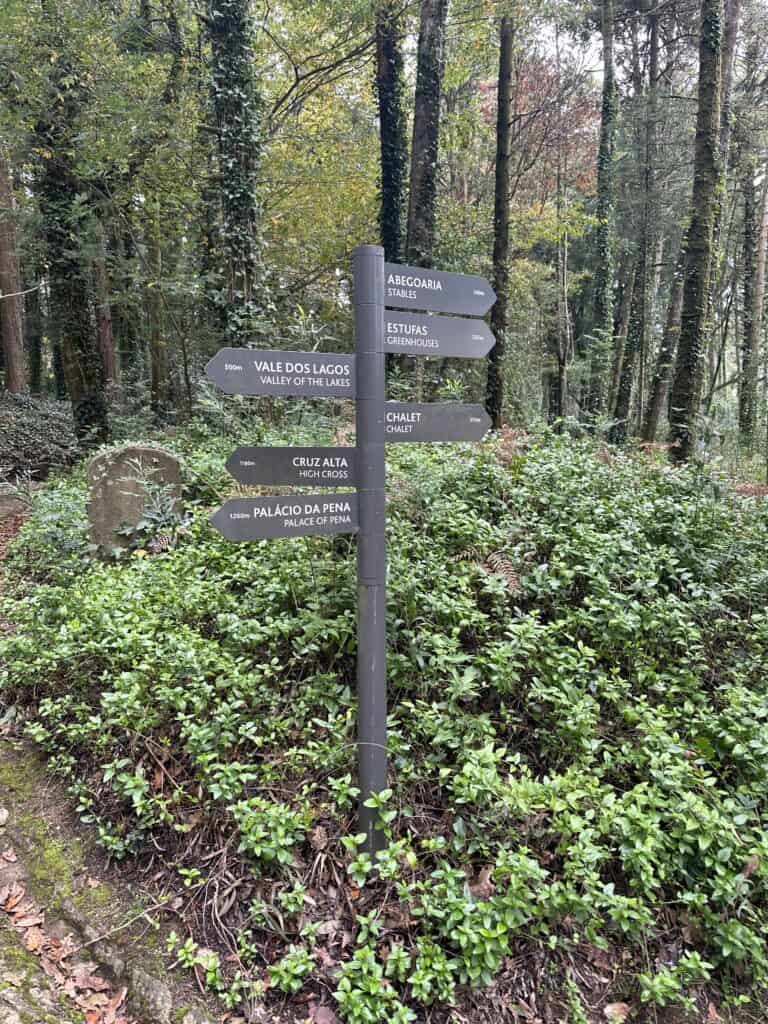
I got another good view of the palace…
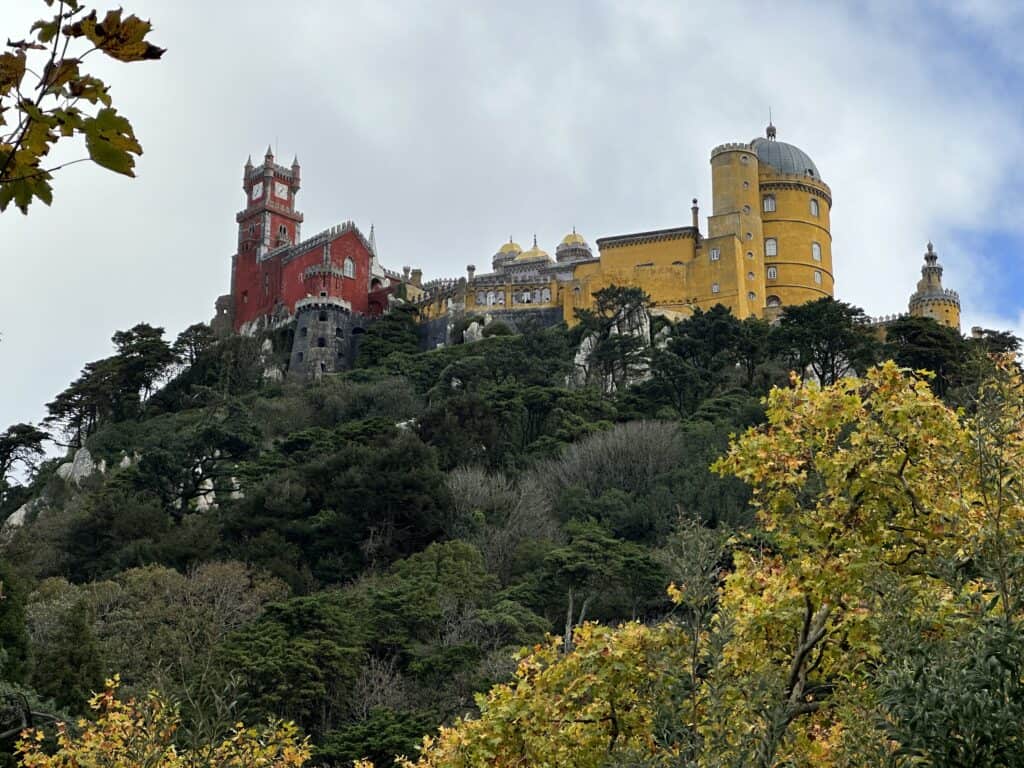
…and found myself in what I think may have been the Valley of the Lakes – well there was a lake there anyway.

And miraculously just beyond that, was an exit from the gardens! I was beginning to feel a bit knackered after my trek so couldn’t believe it when the 434 bus turned up. I had thought about walking back down into the town but felt the bus turning up at such an opportune moment was too good to miss. It also wasn’t exactly clear where to start walking into town.
I paid a single fare again (still cheaper than the day ticket they tried to push on me! Take that Scotturb!) and sat down.
And not long after I made a fatal error, which I would regret for a very long time. As the bus trundled down hills, I spotted a small market, and pressed the handrail button to stop the bus, thinking it was the old town.
I also thought the market could have been a good place to have lunch, but as soon as I started walking through it I realised that a) perhaps this was not the old part of town after all and b) it looked like the stalls only took cash, which I didn’t have.

This seemed like a real market for the locals though as opposed to a tourist trap. There were stalls selling colourful fruit and veg, and even a truck selling budgies!
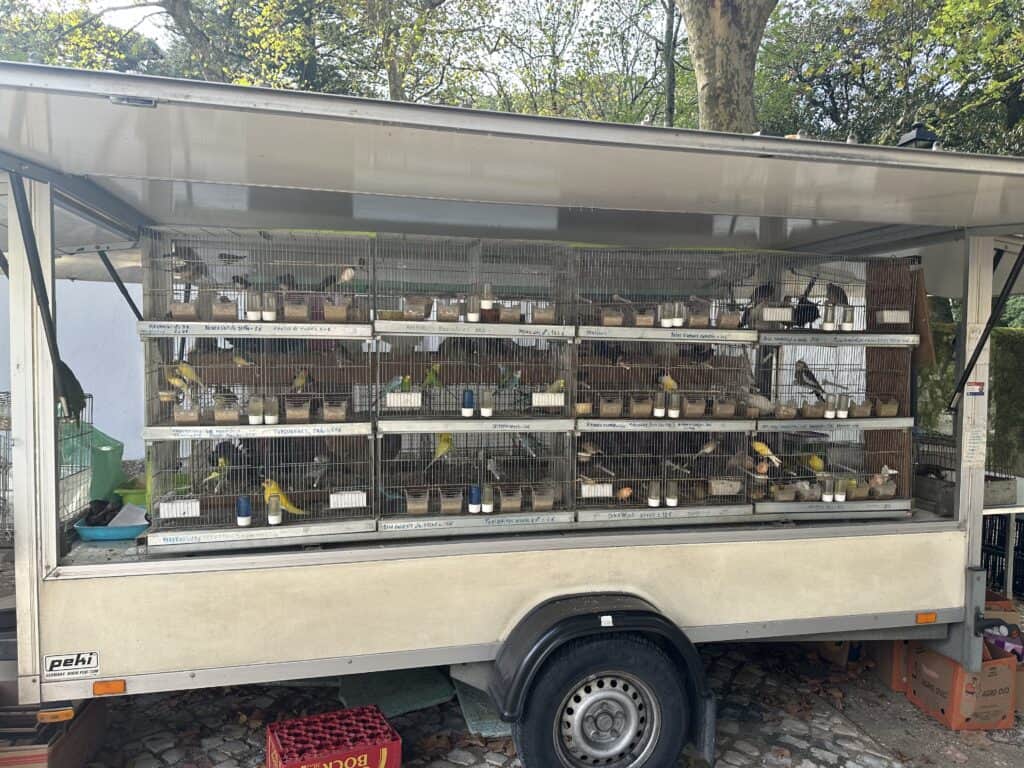
Looking on my phone, the old town was nowhere near the market. With nothing else for it, I worked out where the town centre was and started walking, silently raging I’d got off the bus too soon.
I walked down narrow pavements…

And yet more twisting paths…

Before eventually coming to Sintra’s pedestrianised centre. It didn’t quite look like the place bustling with tourists and souvenir shops that I’d imagined…
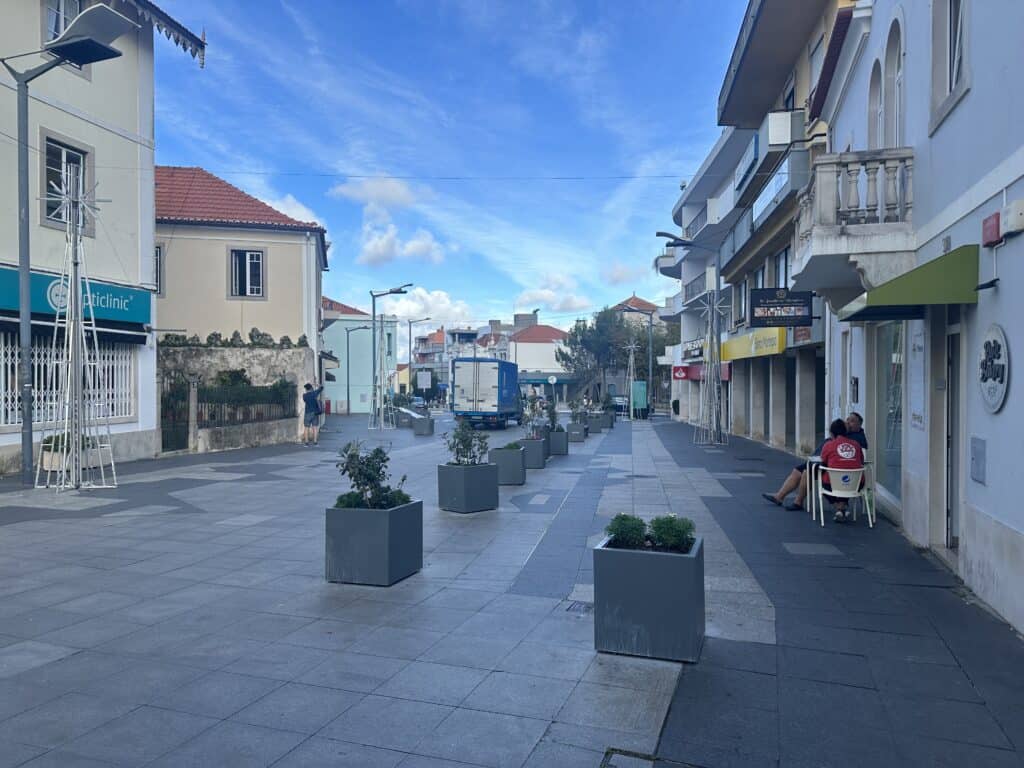
…and I’d later discover that was because I hadn’t found the lively old part of town! I was in the pedestrianised city centre which was different. The only place for lunch seemed to be lacklustre looking cafés, so I decided to give them a miss and head off to the second attraction of the day. It was a twenty five minute walk away! I was already a bit knackered. As soon as I rounding the corner to set off I was greeted with this…

Brilliant! More hills!
The Quinta da Regaleira
I wasn’t quite sure what the Quinta da Regaleira was as I made my way there, but it looked and sounded interesting. It was the work of Carvalho Monteiro – a freemason who with the help of Italian architect and stage designer Luigi Mancini – created a palace as well as a bewildering array of mysterious garden features such as wells you could walk down and tunnels that take you from one part of the garden to another.
As I approached the entrance to the grounds, I thought the palace reminded me of something from The Munsters or The Addams Family!
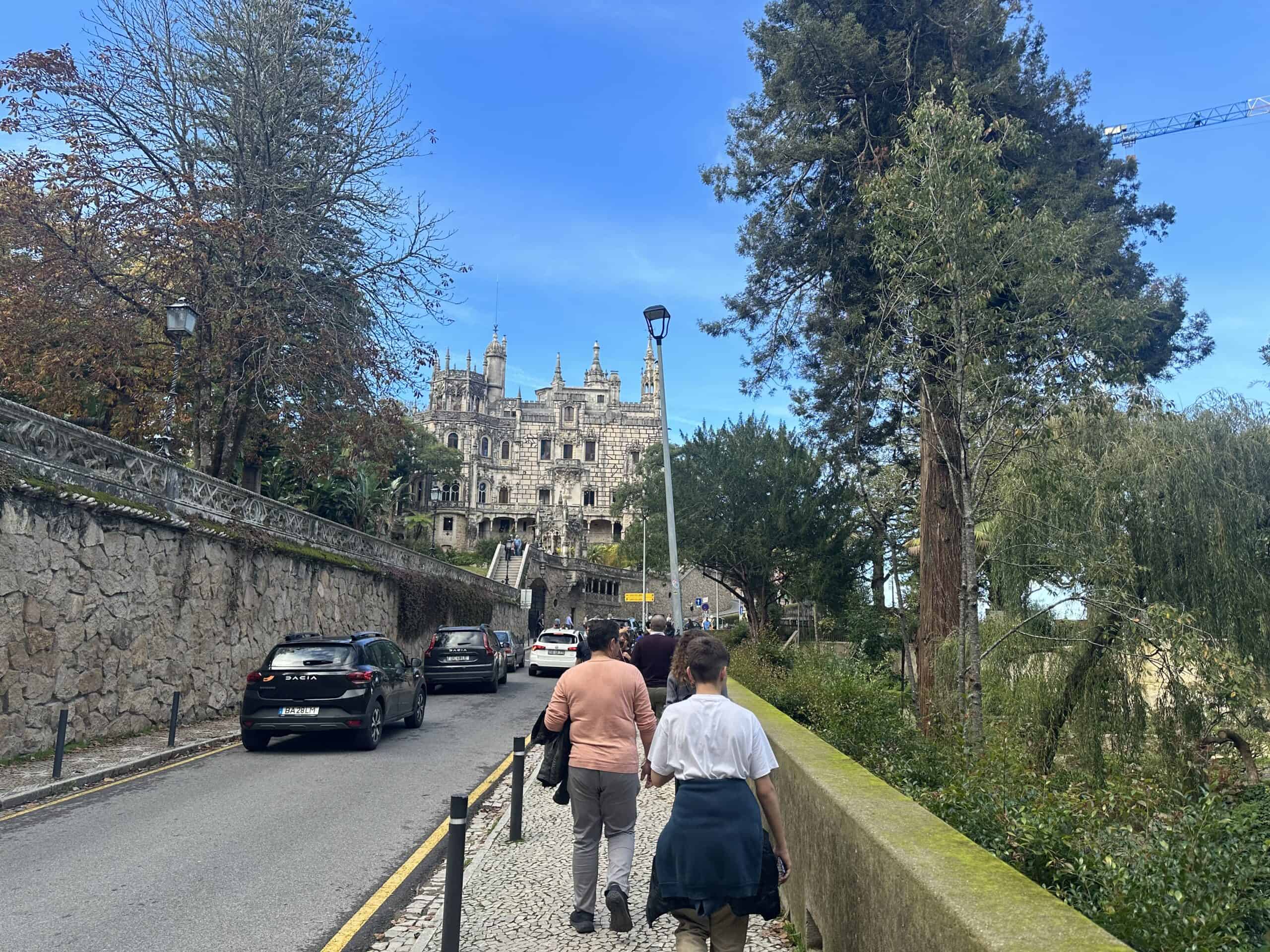
I’d really had enough of walking by now – and unfortunately the entrance was around the corner and up another flipping hill…
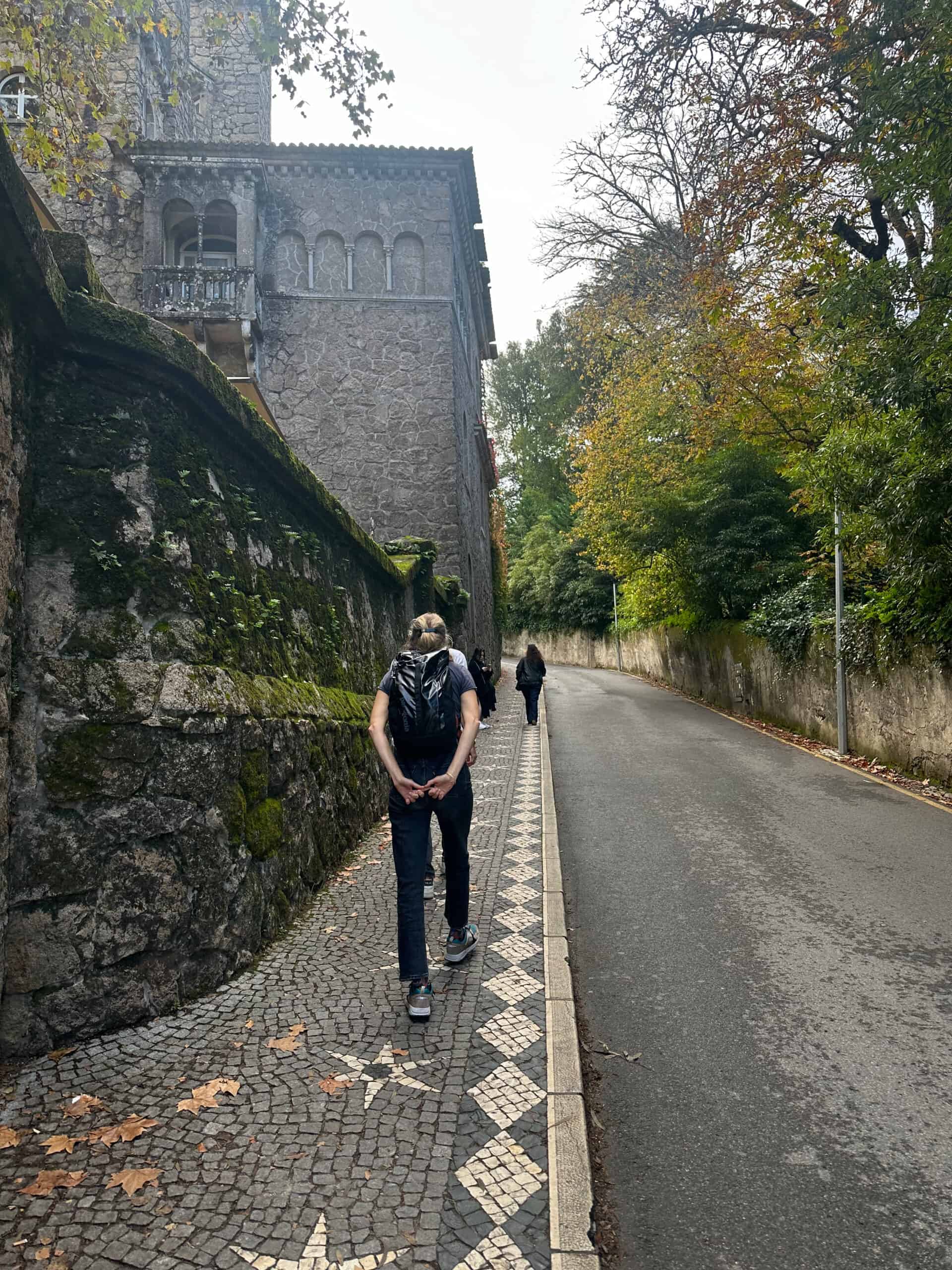
I’d purchased my ticket online, but to get a map you had to join the ticket queue, so I did that and then headed immediately for the café for lunch. I was starving!
I took a table at the back of an outdoor patio space and soon the waitress came to take my order. I had an americano and a baguette with came with some crisps.
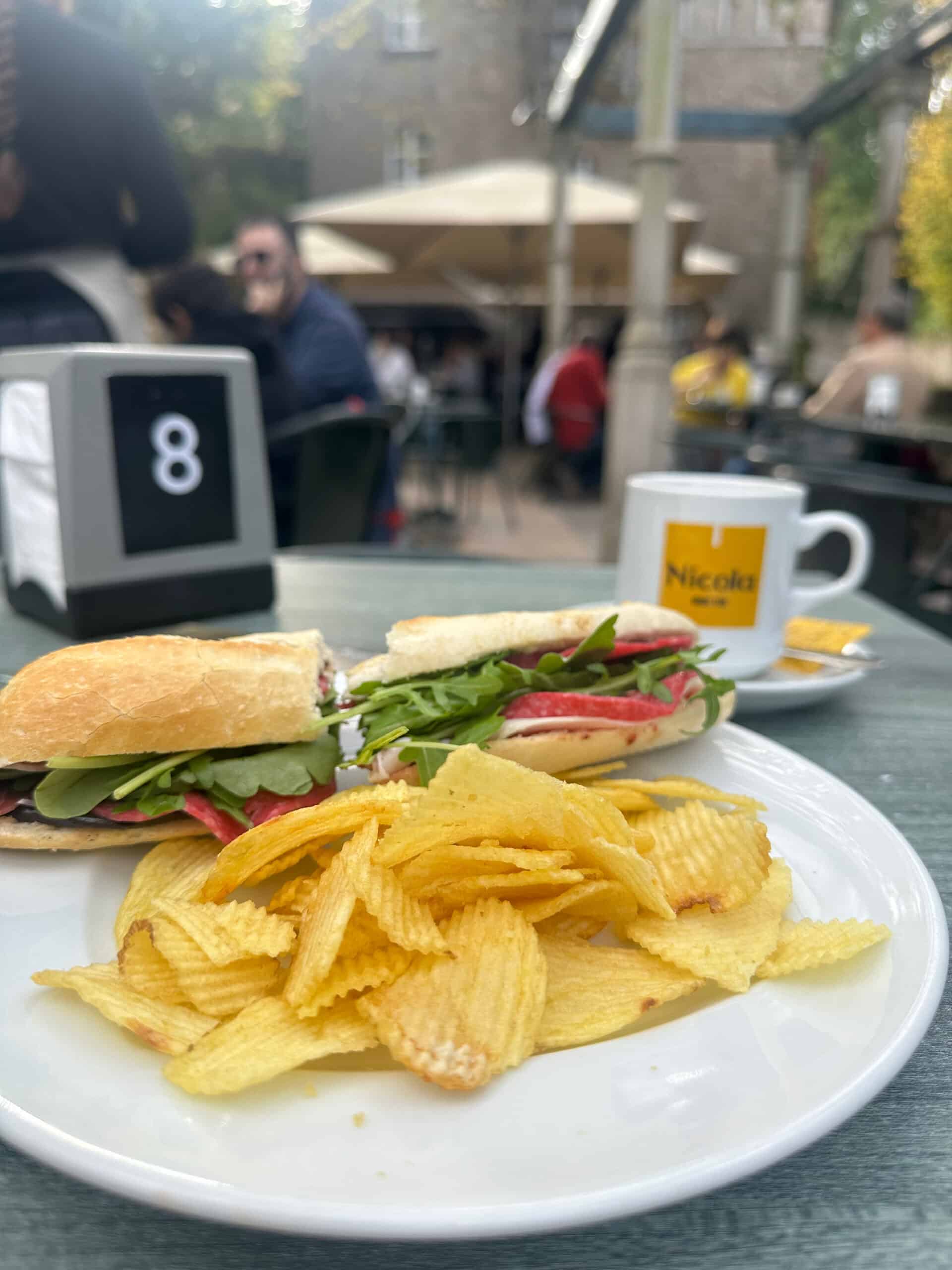
It wasn’t bad but it wasn’t anything spectacular either – I guess as a result of the café having a captive audience!
My hunger sated, I wandered into what seemed like the main part of the house – to me it looked more like a house than a palace.

While the outside was more ornate than the palace I’d visited in the morning, inside was definitely styled in a more traditional way. I made my way around the house, reading some of the displays, but it didn’t take long – literally just five minutes. I dunno maybe I was just a bit too knackered to take it all in!

The gardens seemed like a much more interesting experience, so I headed off to explore them. Thankfully they were much smaller and much easier to navigate than the gardens of Pena Palace!
I felt the map/guide I’d bought at the ticket counter didn’t really do a great job of explaining the whole setup or history of the palace and gardens and why they were designed the way they were, or what lay behind each of the features. So as I navigated my way around I felt I was just missing out on the story behind them which was a bit frustrating.
I climbed up to a path to take me to the back of the gardens, which gave me a good view of the main house and the chapel that lay not far from it.

I guess if the gardens had been in the UK you’d describe their features as follies – there were little strange towers and turrets wherever you went, and I would have liked to know what Monteiro was thinking about – or what he planned their purpose to be when he had them built!
There was this little tower…
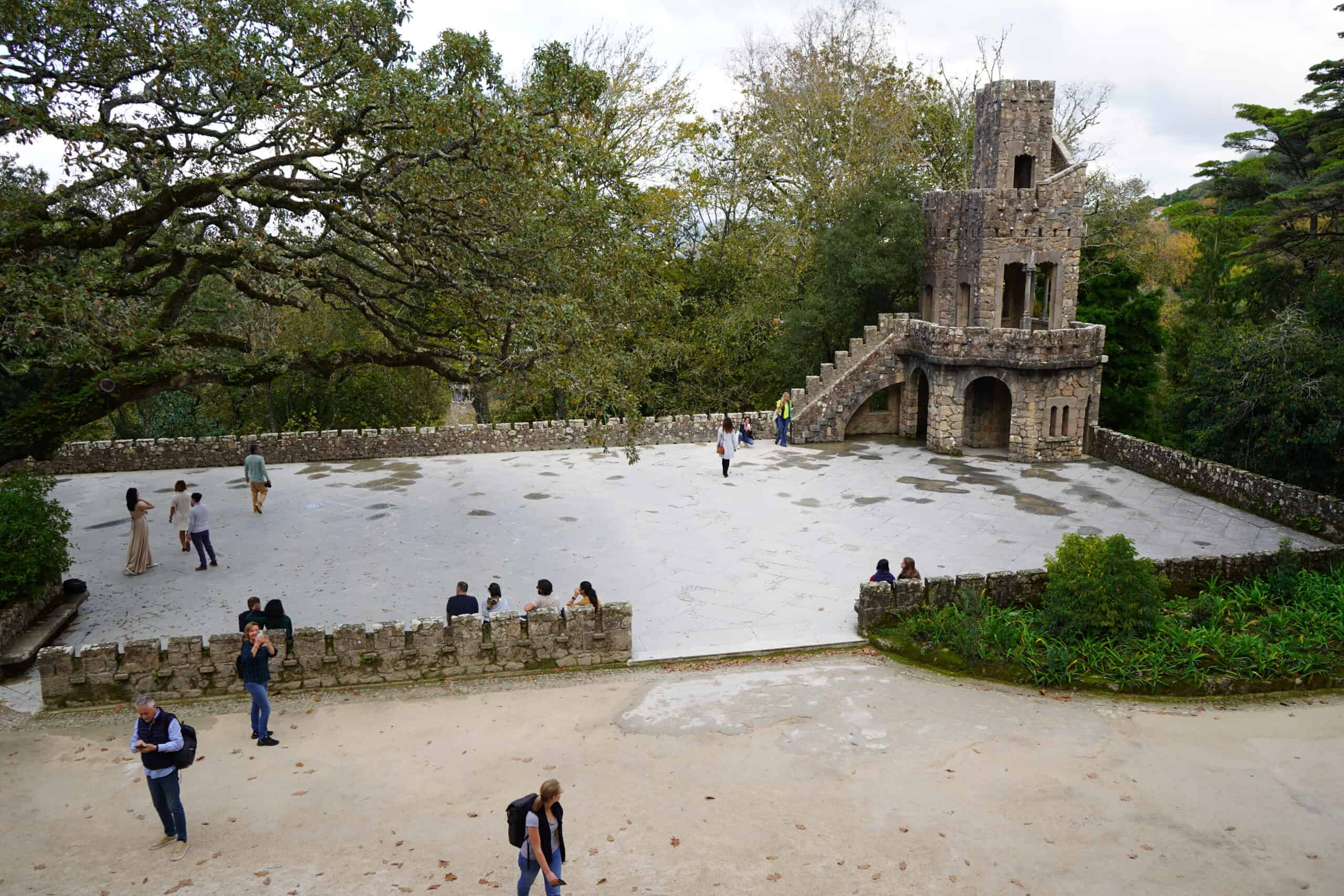
…and little vantage points where I guess he maybe just wanted to sit and relax and admire the grounds…
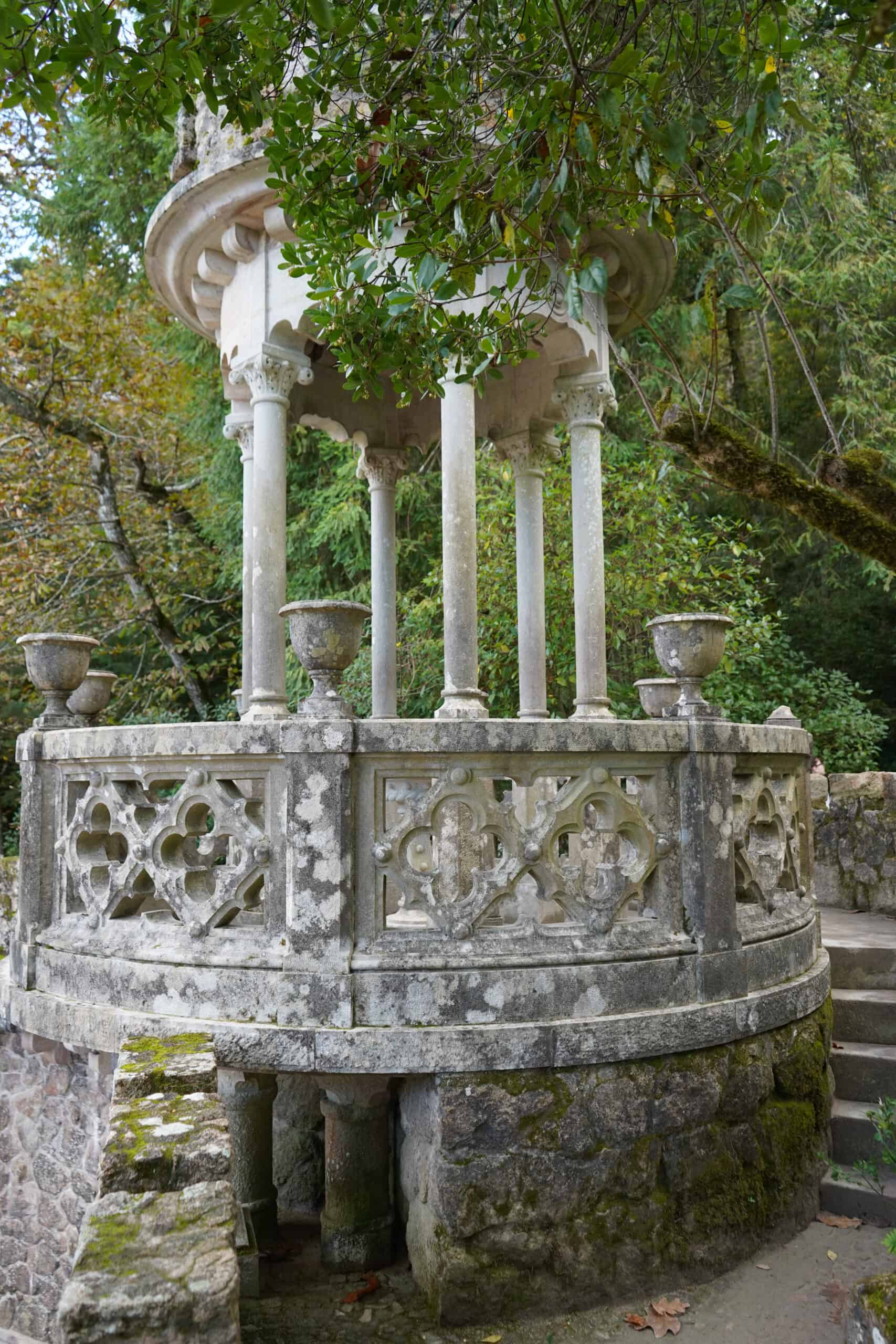
I made my way towards what is probably the most popular feature of the Quinta de Regaleira’s gardens – and found a long queue snaking around the entrance. After joining that and waiting for about fifteen minutes, I was soon descending in to the Initiation Well through this tiny entrance!
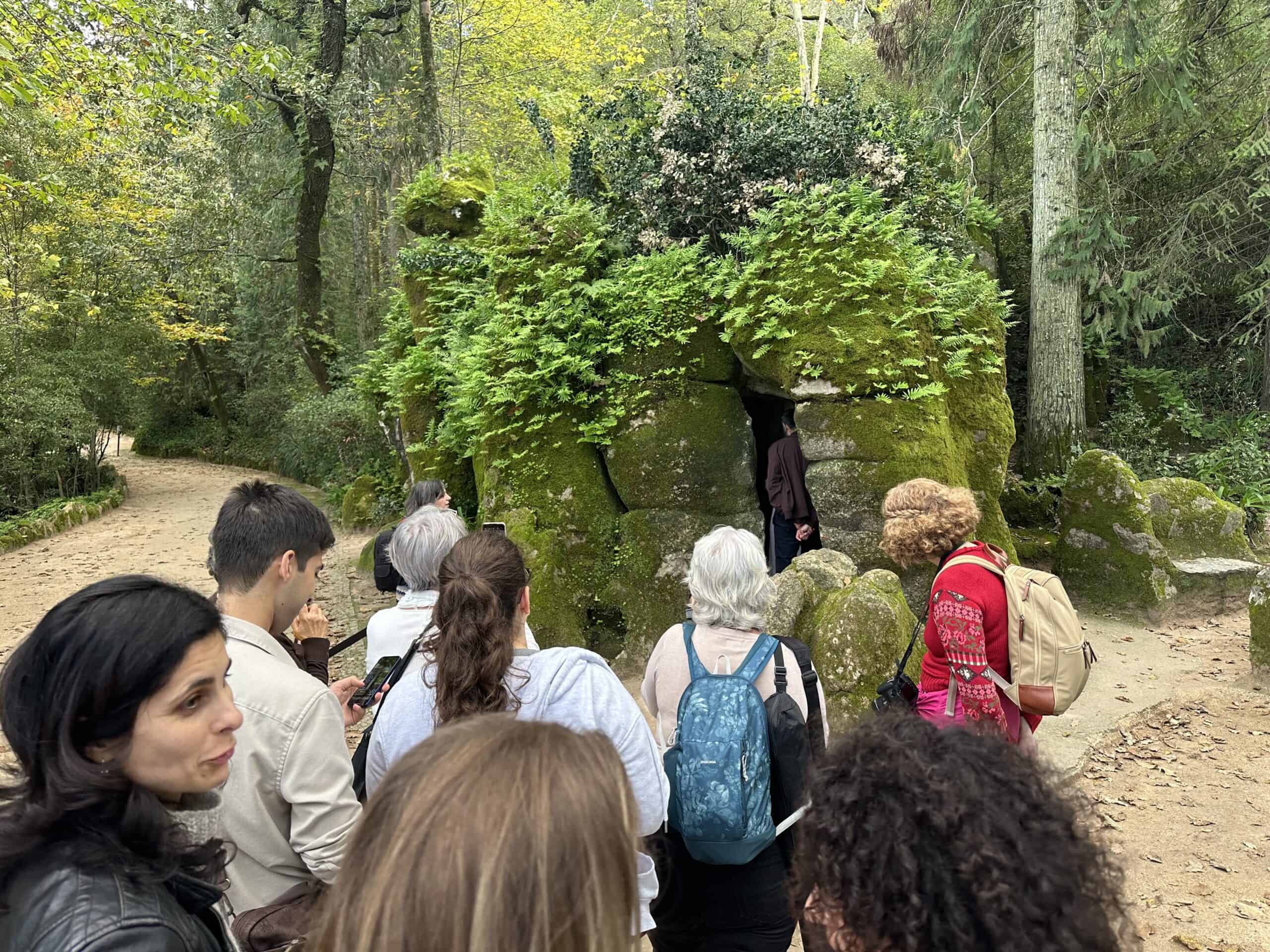
What exact purpose the well served is still a bit of a mystery. Some have suggested it’s modelled on Dante’s nine circles of hell. It’s also thought it might have been used for ceremonial purposes – with blindfolded people entering one of the walls and holding a sword close to their heart as they descended the nine flights of stairs. Only after finding their way back to the chapel were they potentially welcomed into the brotherhood of the Knights Templar, of which Monteiro was possibly a member. It was all very mysterious but pretty cool!
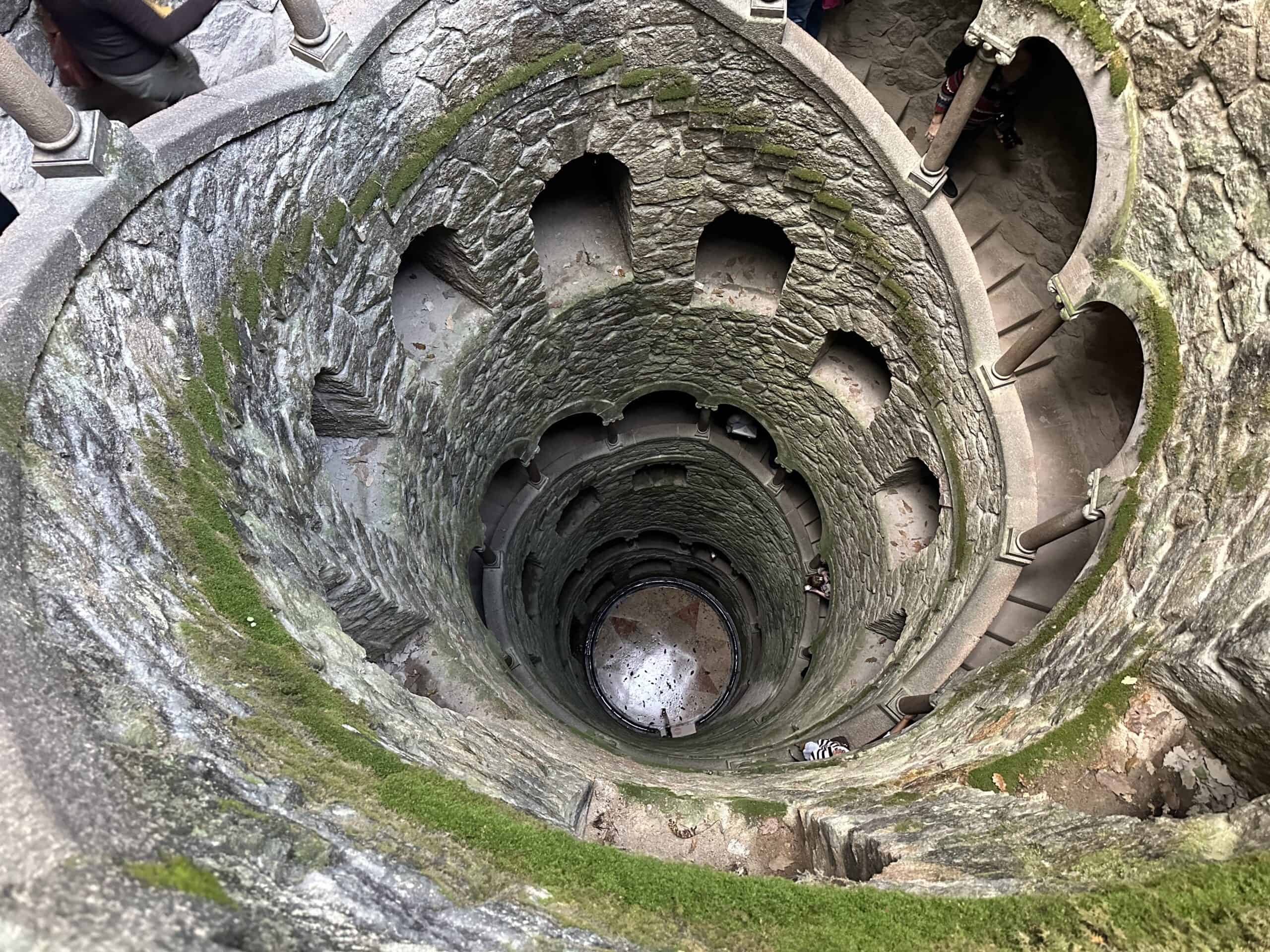
The only circle of hell I was experiencing as I climbed down into the well’s depths was people stopping literally after every step to take four hundred photos from every angle!
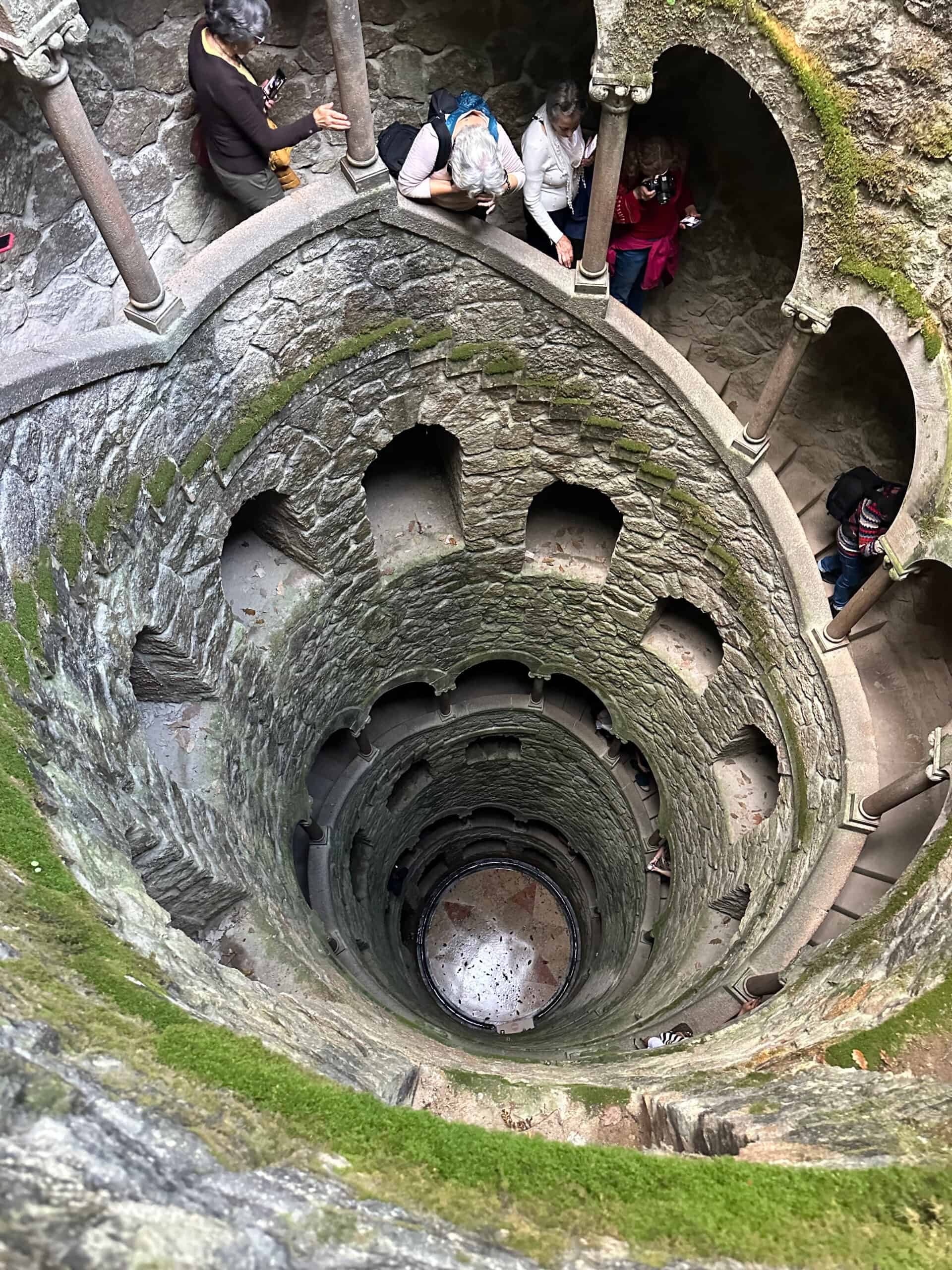
Once at the bottom you were in a cool grotto style tunnel. It was pretty neat really!
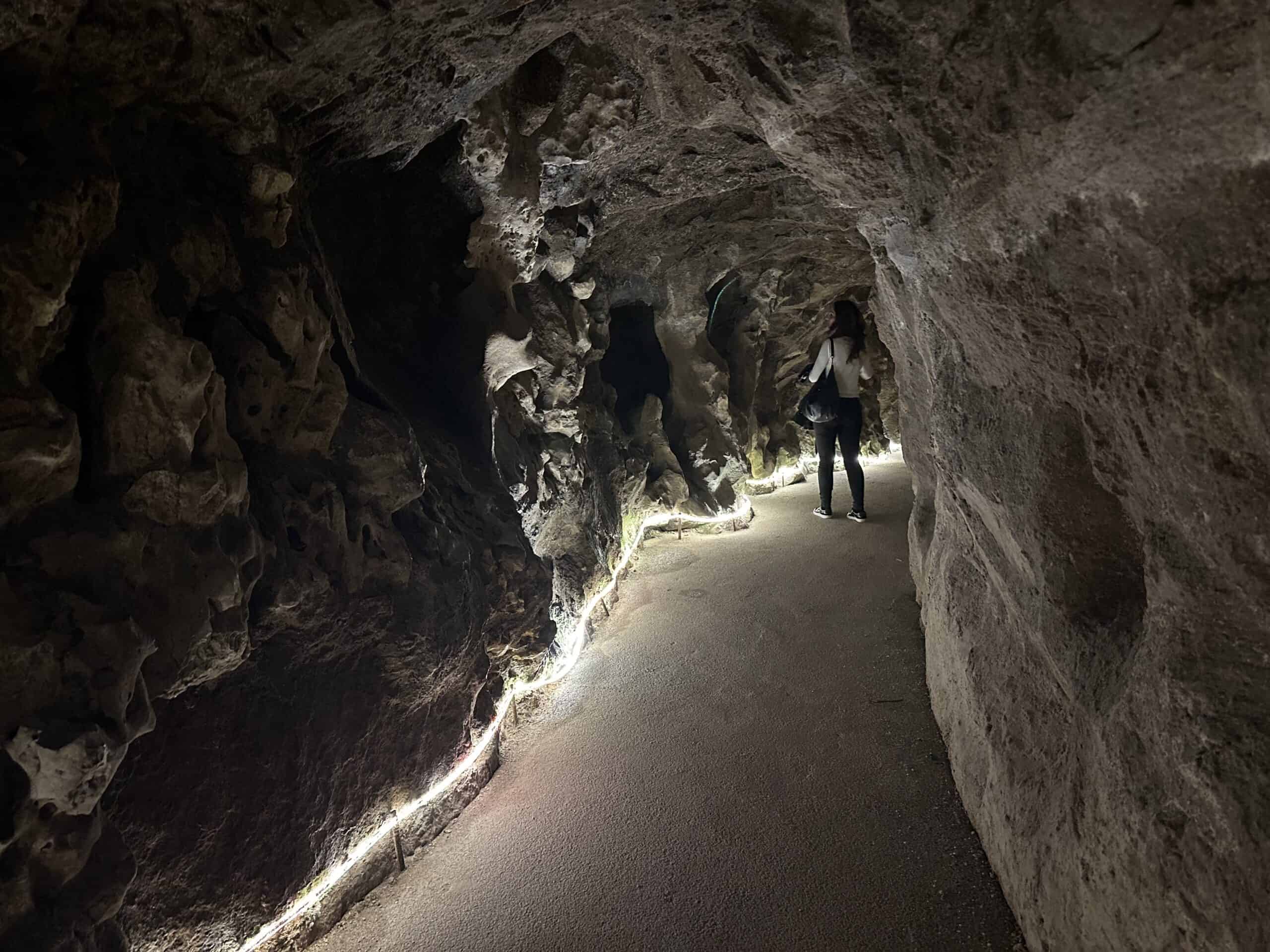
Emerging back into daylight, I decided to go off and explore some other features of the gardens. It was quite chilled really just walking about, even if I was still exhausted from all my walking earlier.
There were curved structures with entrances that took you into tunnels…

And vantage points that let you look down on little lakes…

I also explored a very dark, and dank tunnel with the help of the torch on my phone.

Little statues dotted around the park kept a watchful eye on proceedings.

After wandering around for quite a bit and satisfying myself that I’d seen everything, it was time to face the walk back uphill to the old town of Sintra – would I find it this time?!

Overall I’d recommend a visit to Quinta da Regaleira. Frustratingly I just felt there wasn’t really that much information to help you put the sights you were seeing in any kind of context or to learn more about the place. Perhaps if I’d downloaded the audio guide that may have helped, but after listening to one all morning at the palace I’d decided against it.
A quick look around Sinatra’s old town
I left Monteiro’s mysterious grounds and headed back into town. Eventually I found myself in narrow streets which I think was actually the old town which had eluded me earlier! It was pretty touristy with little souvenir shops.
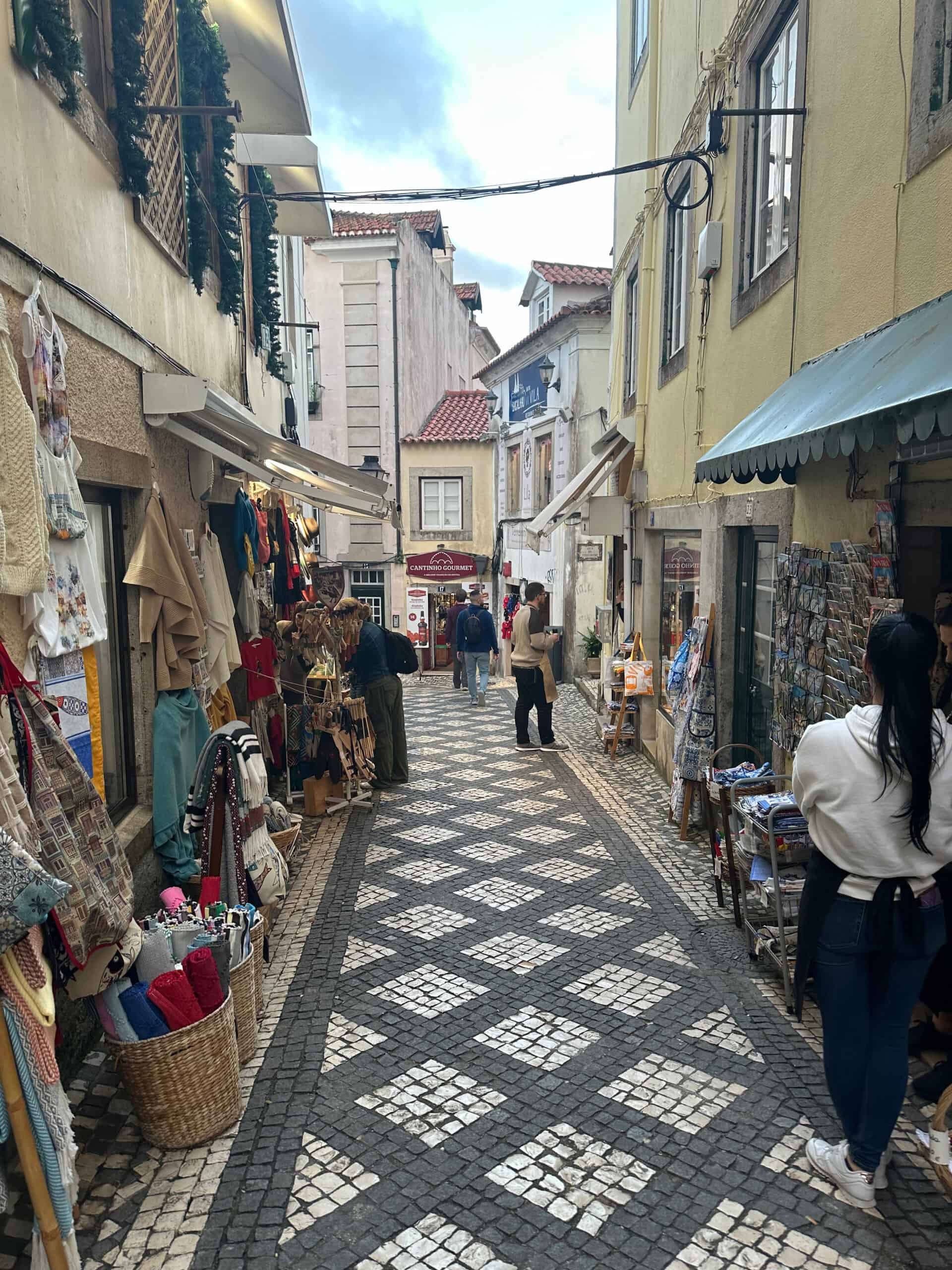
I saw a queue outside one little store, and recognised it as a place I’d read about in one of my guide books – Piriquita – a little bakery selling local sweets.
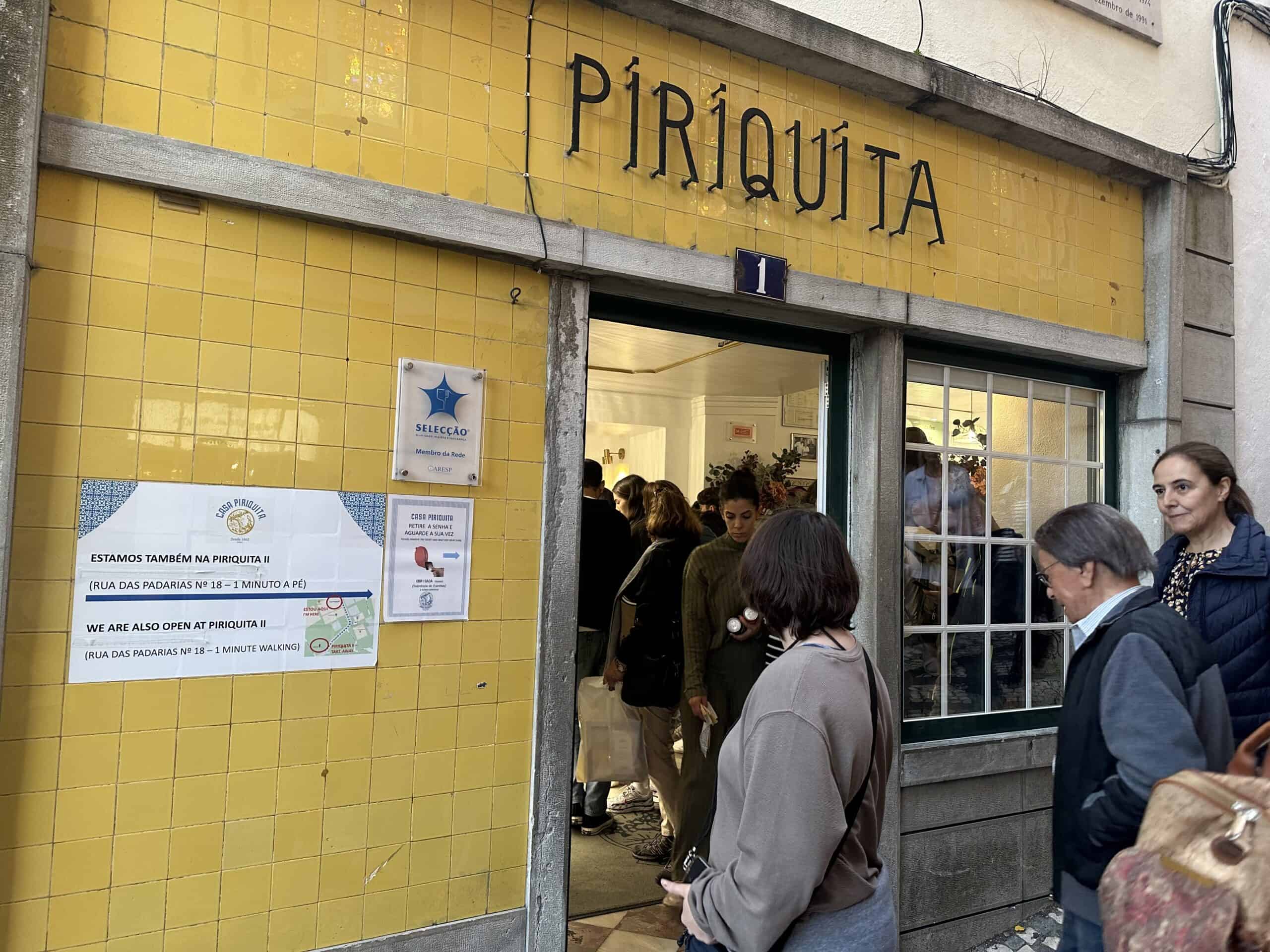
I joined the queue and pretty quickly was inside, despite just one man behind the counter tackling the entire line of customers!

Gazing at the cakes I settled on a travesseiro and a Purim de Laranja.
The travesseiro’s a long puff pastry cake filled with custard cream, almond and a “secret ingredient”.
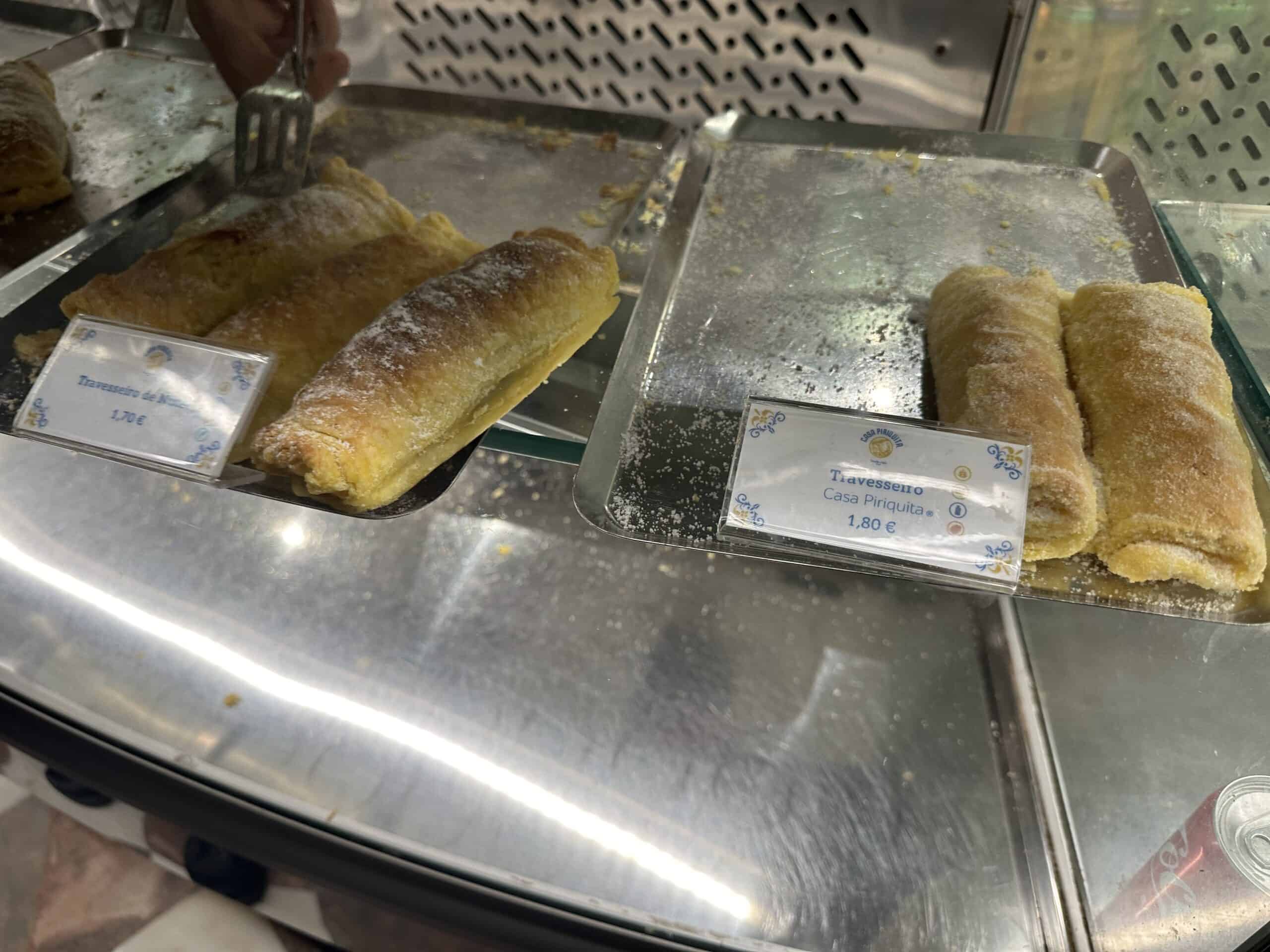
The Pudim de Laranja, meanwhile, was like a little orange flan. I bet you can almost taste it looking at it!

I got the two cakes in a box and thought I’d save them for the train back to Lisbon, and had a bit of a wander around.
Across the square was yet another palace – this one the National Palace of Sintra. There’s definitely no shortage of attractions in the small town!
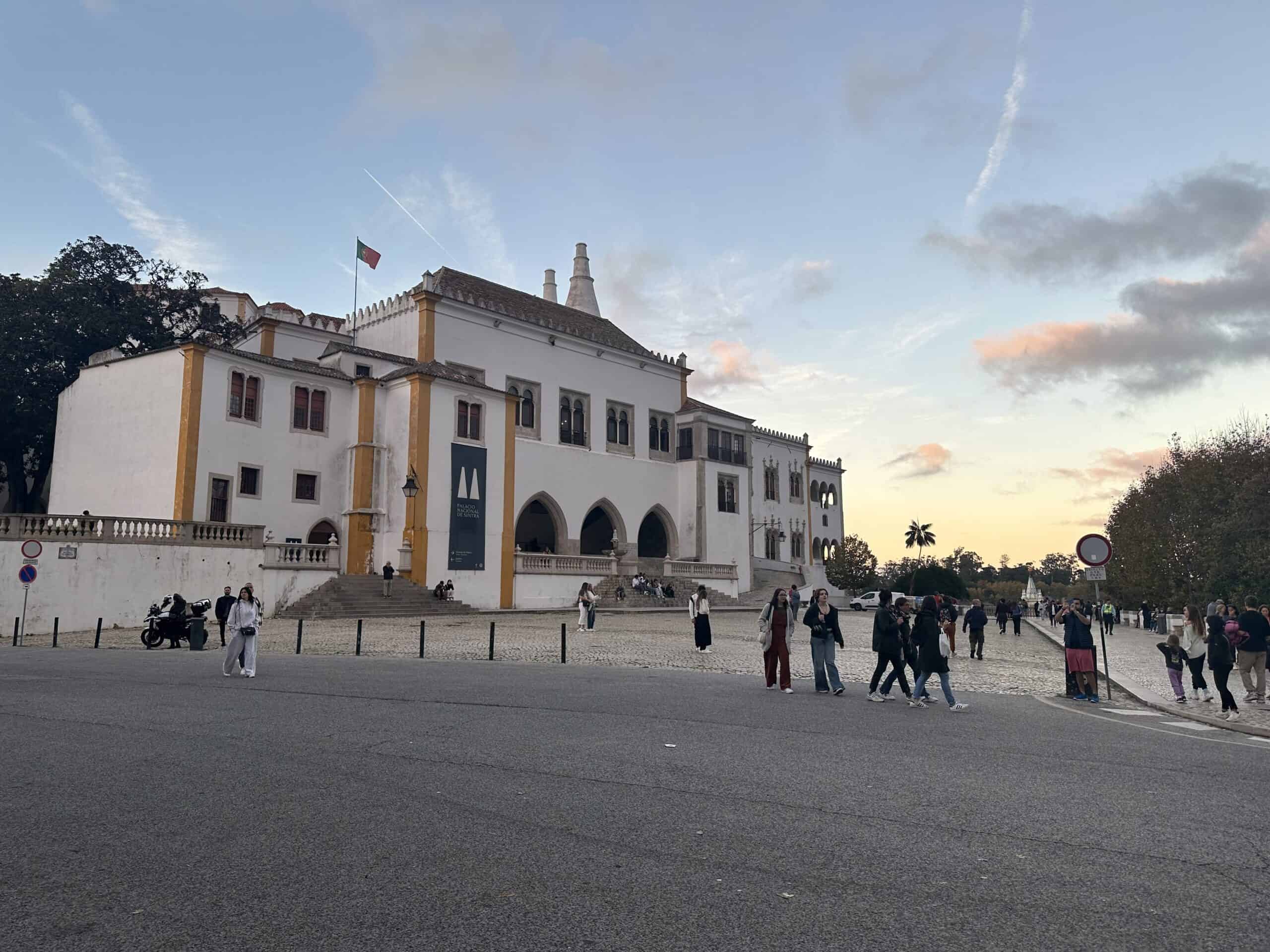
I picked up a couple of small postcards in an arty souvenir shop which I thought I might pop in a frame when I got home…
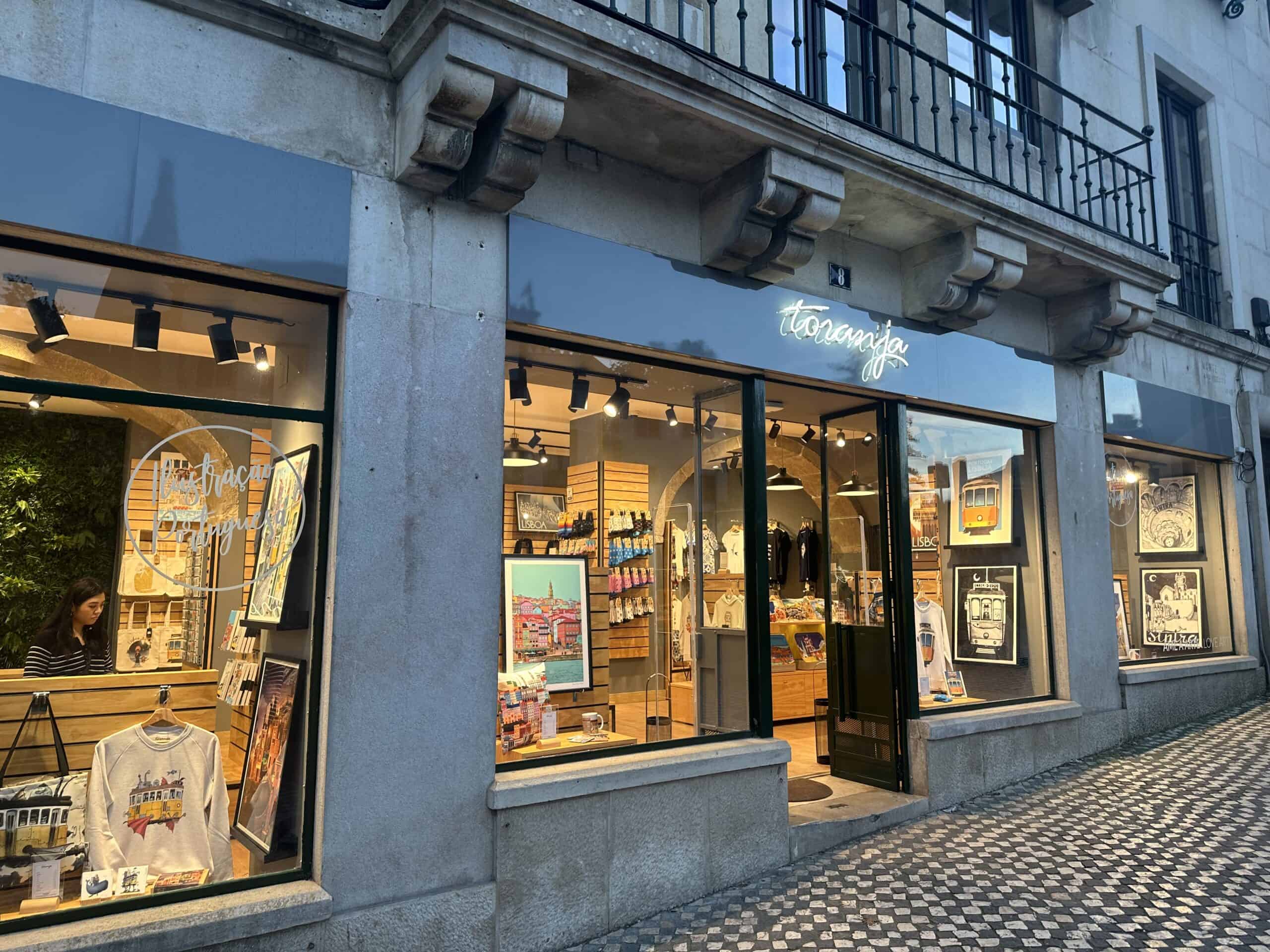
…and then with the sky beginning to darken decided to make my way to the train station. Yet again it was quite the trek.

I couldn’t wait to get back on the train and just get a seat to rest my weary feet!
Panic at the… disco station
When I finally got to the station, chaos reigned. There were three people in front of me for the only ticket machine at the side entrance (which I thought would be less chaotic than trying the machines in the actual station building) but oh my god each and every one of them could not fathom either the machine or the ticket type they needed to buy. Behind me the queue began to grow every longer.
The first pair at the machine took about ten minutes before giving up. The next man got all confused despite some random man standing by the ticket machine waving a ticket at him and trying to explain.
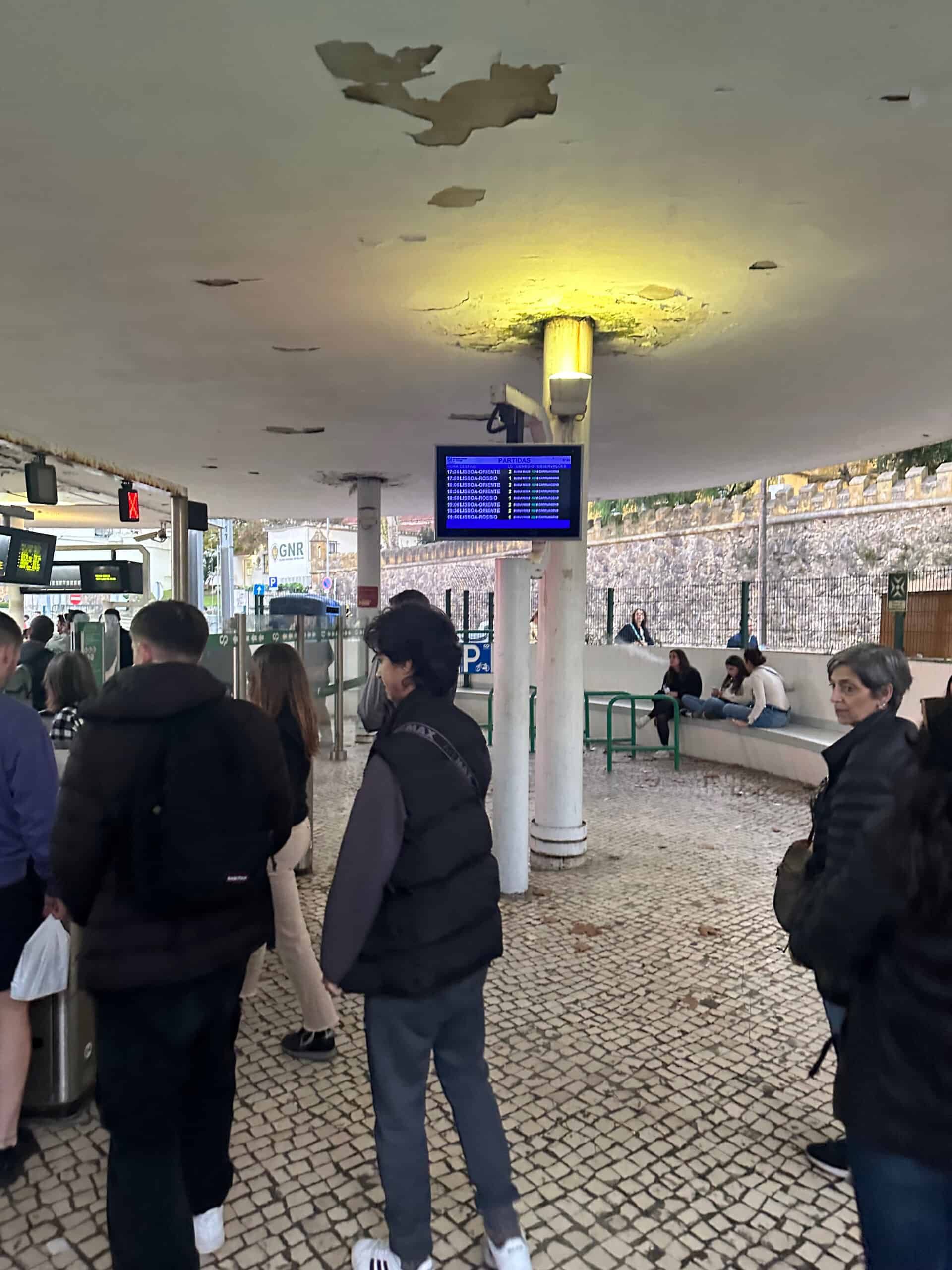
Meanwhile as the departure time of the train back to Lisbon drew ever nearer I was beginning to get a bit of a panicky sweat on. Eventually I got to the front of the queue only to discover that the ticket machine inexplicably only allowed you to add a ticket on to an existing ticket, not just buy a straight forward single ticket. I didn’t have an existing ticket to add a ticket on to. What genius thought that up!
So I decided in a bit of a panic just to give up. The ticket barrier in the station (the machines there had a massive queue too) was wide open so I just walked through it and got on the train. I felt really bad about that, as I always pay my way, but really they weren’t making it easy for you!
The train was absolutely rammed as well but I did manage to get a seat as people all around me sat on the laps of other people and filled the aisle standing.
The only consolation for my aching legs and my cramped, noisy surroundings were that I had my cakes! I opened them and scoffed them down.

They were nice, but there was nothing particularly memorable about them! The little orange flan was my fav.
Finally we pulled into Rossio Station and my knackering trip to Sintra was finally at an end.
My top tips for Sintra
If you ever find yourself on a day trip to Sintra my tips would be:
- try and argue for a return ticket on the 434 bus – I still don’t believe it’s just for groups as the Pena Round Trip ticket is advertised on their website!
- make sure you work out where the old town is and don’t get off the bus too early on your way back from Pena Palace
- get there as early as you can – I was one of the first people to arrive at Pena Palace on the first bus of the day, and I can’t imagine how busy it would be later in the day
- be aware that you will be walking a lot – particularly if you explore Pena’s Gardens and decide to walk from town to the Quinta da Regeleira
The best spot for dinner in Lisbon
Back in Lisbon I’d got some recommendations for dinner spots after my food tour on Friday and I’d decided I’d go out for dinner and try one of them.
On my way back to the hotel I stopped off at one that had been mentioned. Casa do Alentejo celebrated its 100th anniversary in 2023, and is a community centre for people from the Alentejo region of Portugal.
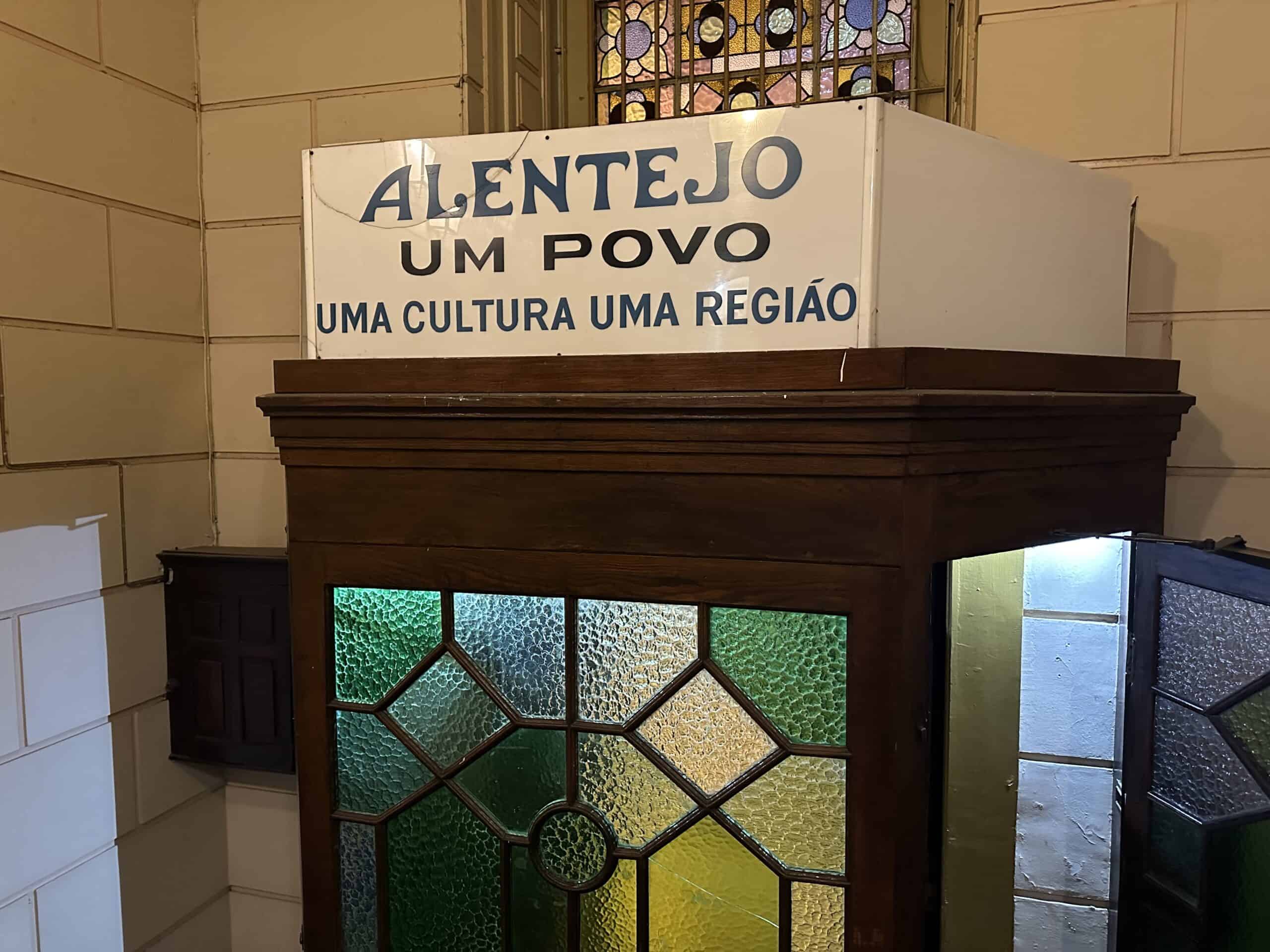
It’s a pretty cool space with a Moorish type square inside.
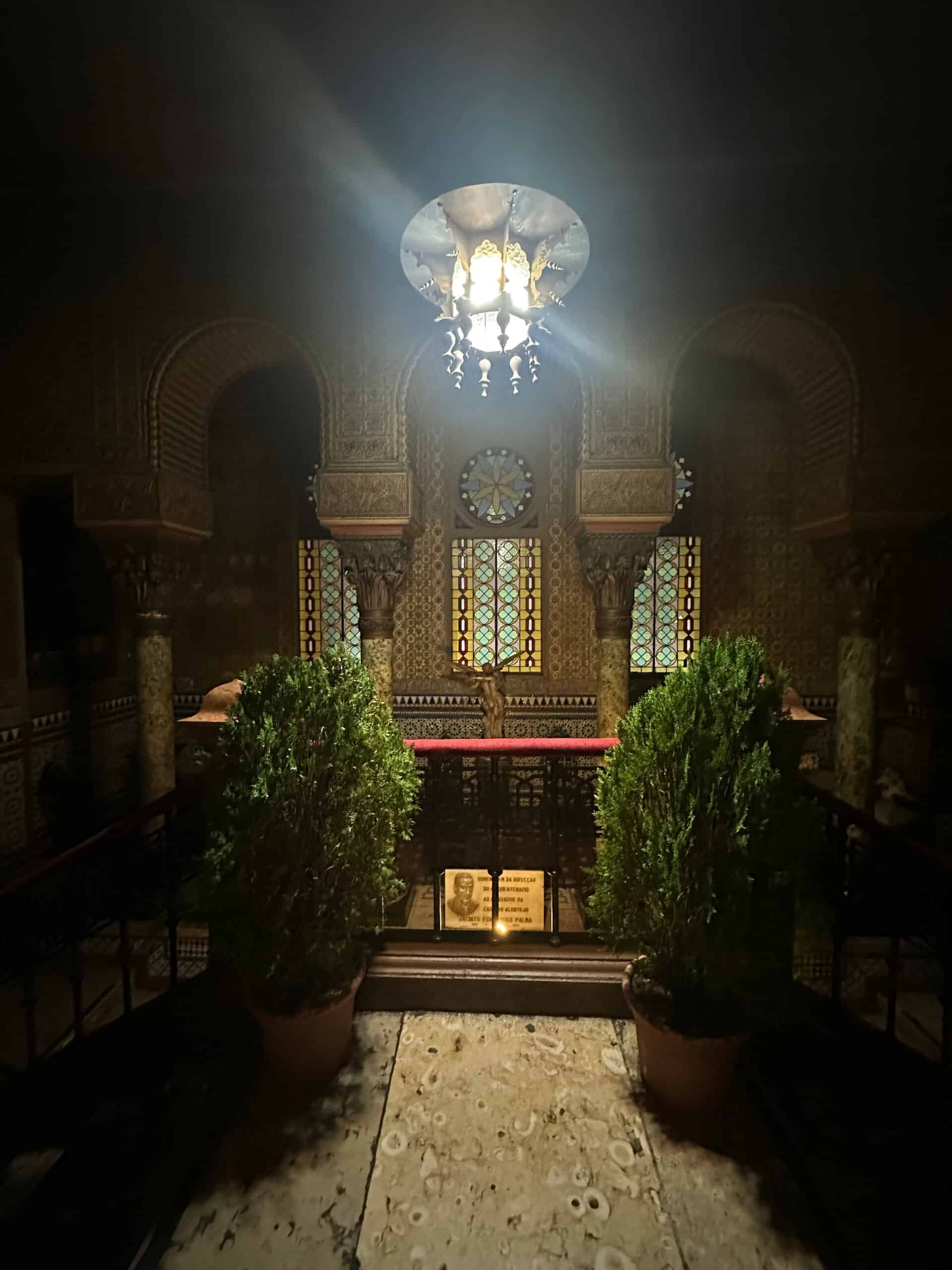
While the centre’s restaurant wasn’t open for dinner yet, I had a look at the menu but decided it looked a bit heavy and formal for my tastes. If I was back in Lisbon again though I’d definitely check it out as it looked like a nice, pretty hidden, authentically Portuguese experience in a lovely setting.
Back at the hotel I flicked through the restaurant recommendations again and picked made my final decision before having a quick shower and getting changed.
I jumped on the metro and got off at Saldanha station. Right outside the station at ground level was the restaurant I’d chosen – which is a bit of a Lisbon institution.

Galeto opened in 1966 and is famed for serving Lisbon’s lawyers, bankers, families and bohemians breakfast, lunch and dinner right through until the early hours – the restaurant’s open until 3.30am.
It was opened by six emigres from Brazil, and today the owner is one of their sons. The restaurant has over 170 different options and is included on Lisbon’s official Lojas Com História list which covers historic shops.
There was a terrace outside which tempted me, but I decided to head inside for a seat and was really pleased I did.
There are no tables for two – or four – at Galeto. Instead an enormous counter snakes around the restaurant – there’s bar style seating only which means it’s the perfect place for a solo traveller like me!
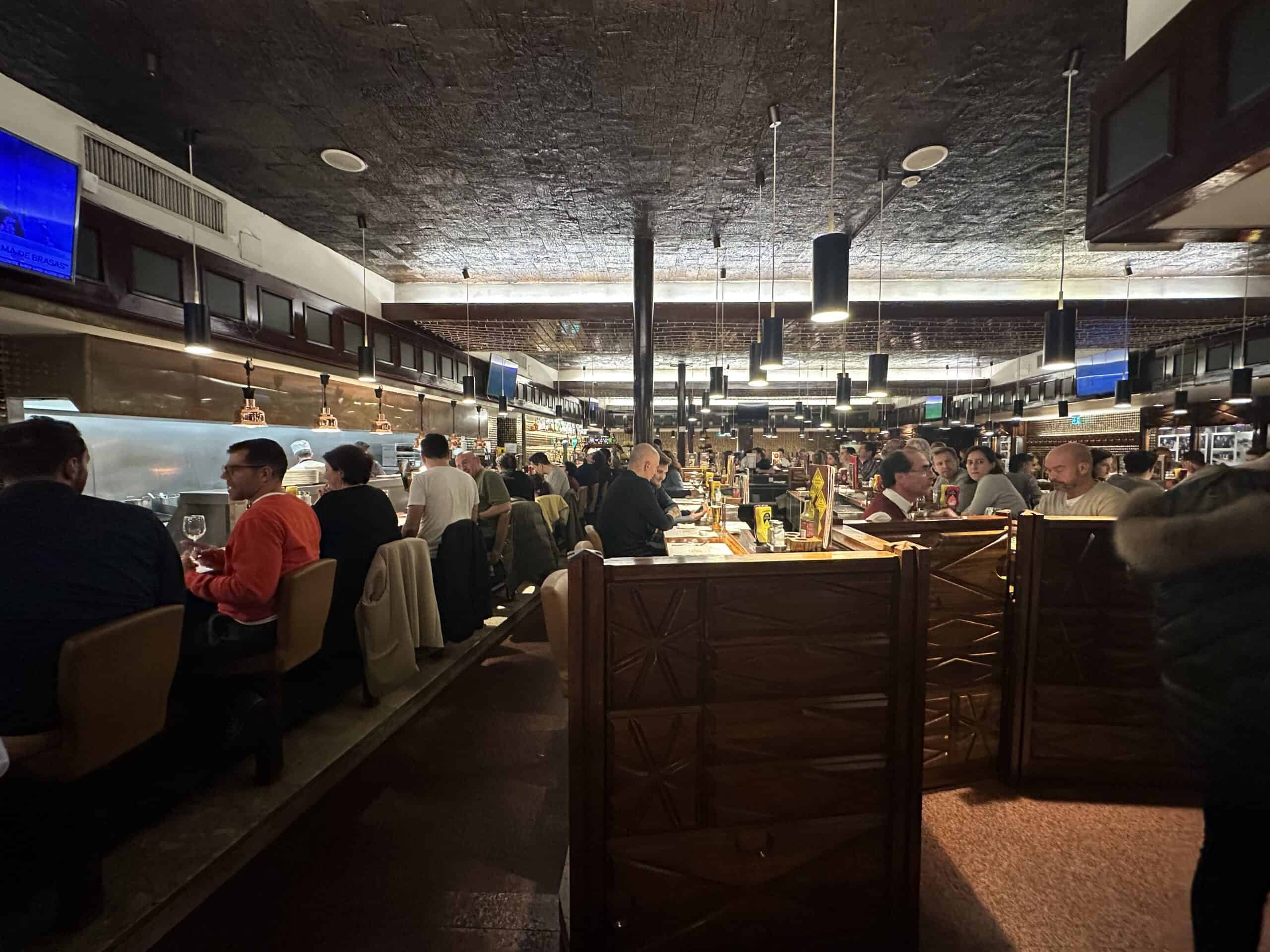
The place had smartly dressed bar staff and an old-school atmosphere that I loved. I’d chosen the perfect place for dinner. I took my place at a counter sandwiched in between an elderly gentleman and a couple with a young boy. The waist-coated waiter handed me a menu and I got the old phone out to start translating. After a couple of minutes the waiter asked if I was English (er Scottish actually) and provided me with an English menu. Perfect!
I felt after my exhaustive trek around Sintra I deserved a bit of a blow-out food wise, so decided to go for a starter and chose Crème de Camarão – a traditional shellfish cream soup.
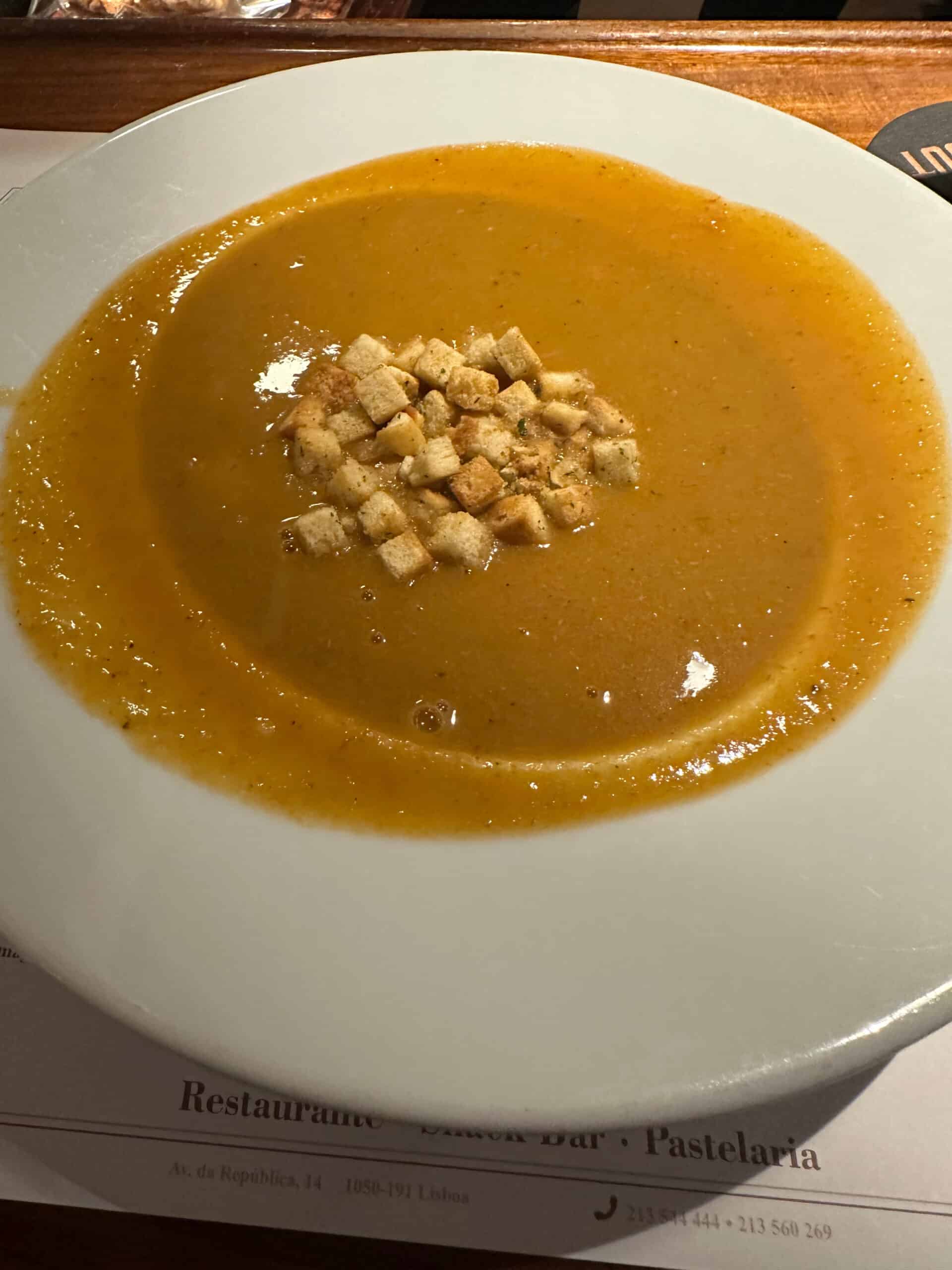
It was really delicious. It tasted of a deep rich prawn flavour and was just warming and tasty. It bode well for the rest of my meal!
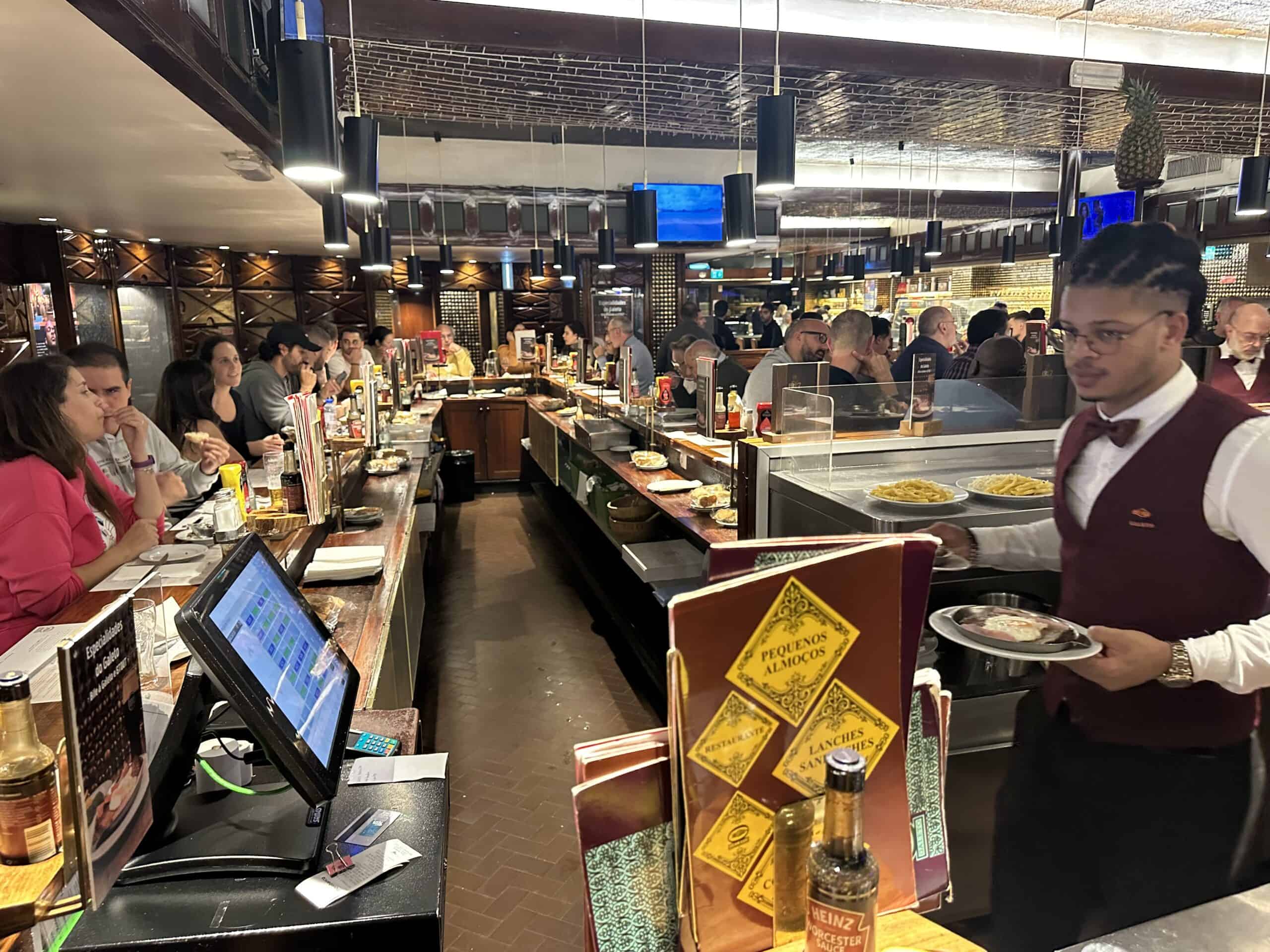
The barman busied himself about as I tucked into my soup and soaked up the atmosphere – there was lively chatter and people sitting eating dinner while reading the paper. It was just really enjoyable having some nice food in a really nice spot, and I was glad I’d made the trek from the hotel, and picked Galeto for a meal!
For a main I decided to go traditional – with the dish titled after the restaurant. Galeto was described as strip loin steak and a classic since 1966.
When it arrived I quickly saw the dish didn’t just consist of steak! It came on a slice of ham with a fried egg, while on the side were some french fries and creamed spinach. It felt like hearty traditional food well done – which was exactly what I was in the mood for. I quickly polished it off.
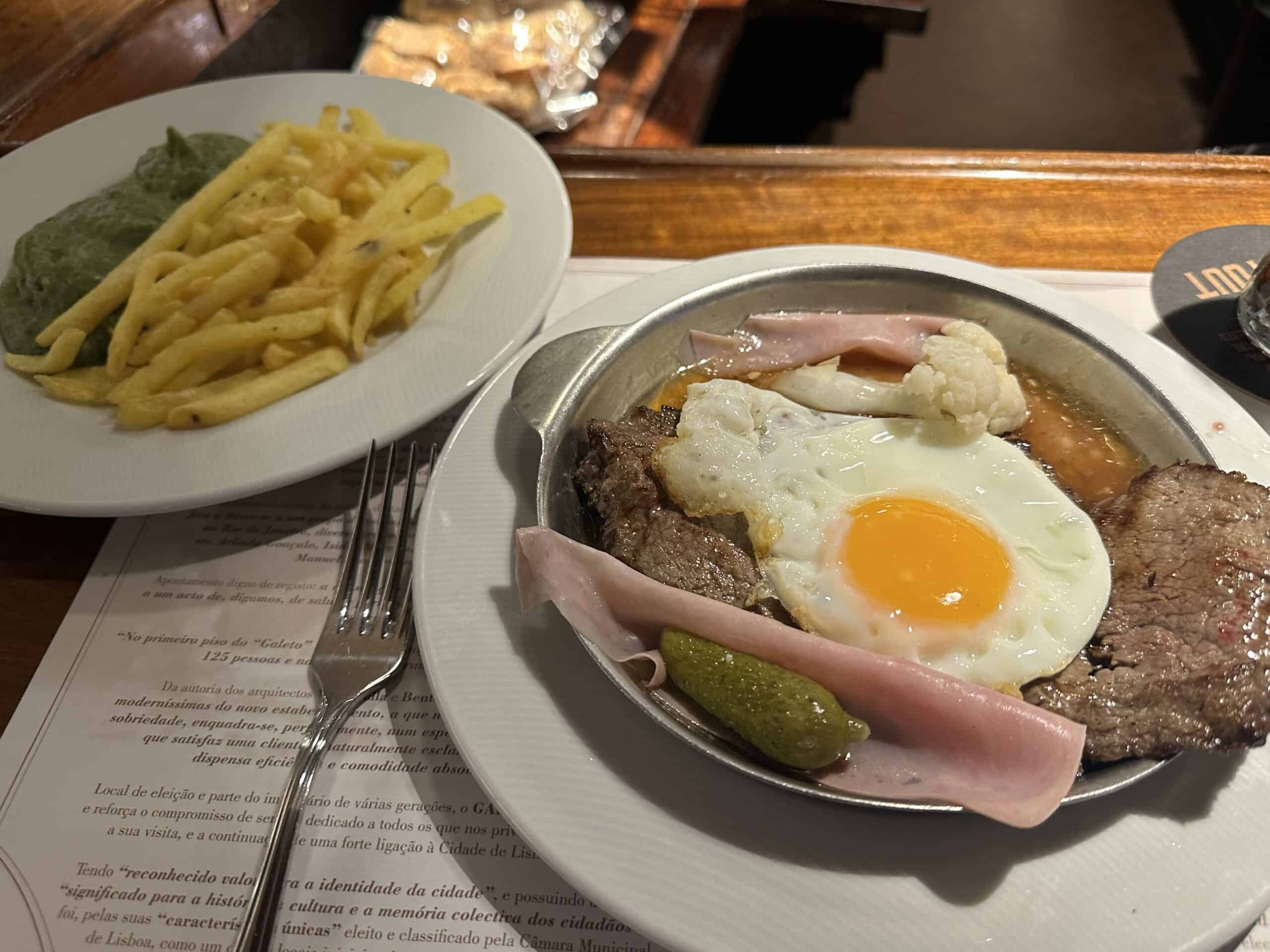
With my stomach slowly filling I decided to go all out – and order a dessert! It would be very rarely that I’d have a three course meal but I felt if I was to do it any day it would be today when I felt I’d covered a million miles walking up a million hills.
For pudding, I chose a rice pudding with cinnamon and lemon zest.

It was served cold, but was tasty and a perfect way to round off the meal.
I’d noticed that food in Lisbon – unlike back at home – was very reasonably priced. A coffee and croissant in the coffee shop around the corner from my hotel was just over €3, while at home I felt it would have been £6.70 (I know that’s precise!). Galeto was no different. I’d had a really enjoyable, quality meal, and my bill, excluding service, came to just €28. That, to me, seemed like really good value. I added a tip, signed the cheque and then on my way out did a tour of the perimeter of the restaurant gazing at old black and white photos that adorned the walls.
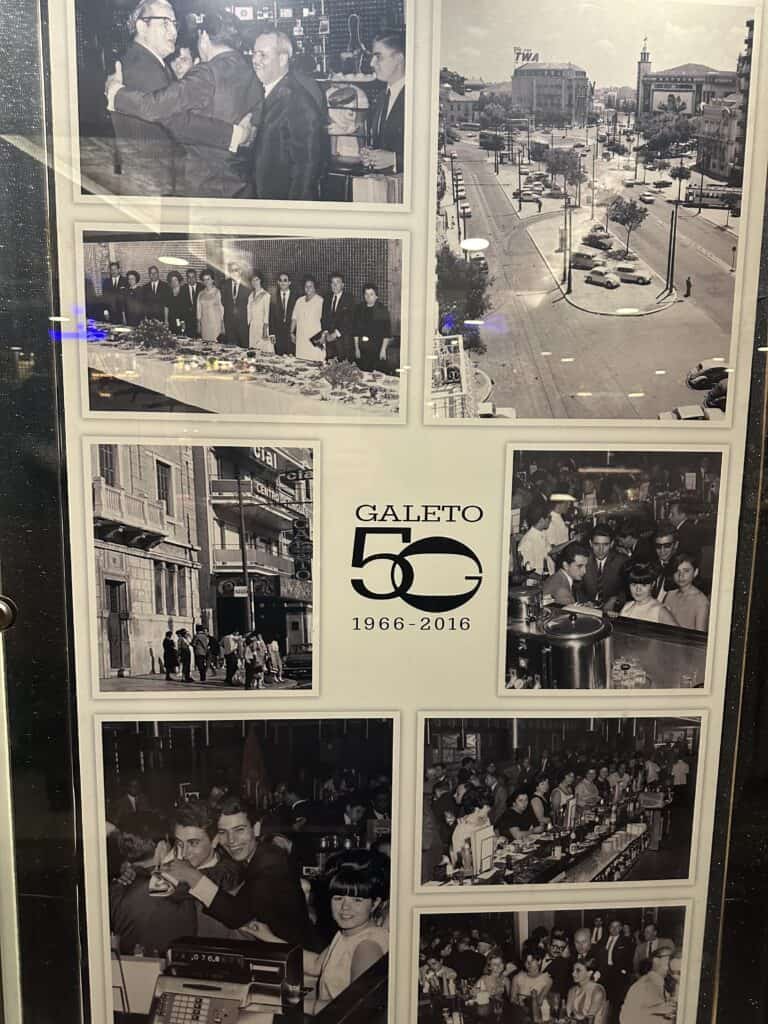
You know Galeto would actually be my top tip for Lisbon. It just felt really authentic, and was a great spot for a meal. I’d really recommend it if you find yourself in the city.
More walking….
Feeling a bit guilty after my three courses, I decided to walk back to the hotel, which Maps showed me would take about half an hour. As I walked the darkened street, it seemed for many, the night was just beginning. I passed street side cafés busy with people chattering away.

I spotted this strangely familiar restaurant on the way back to the hotel – in which country or city had I seen it before?
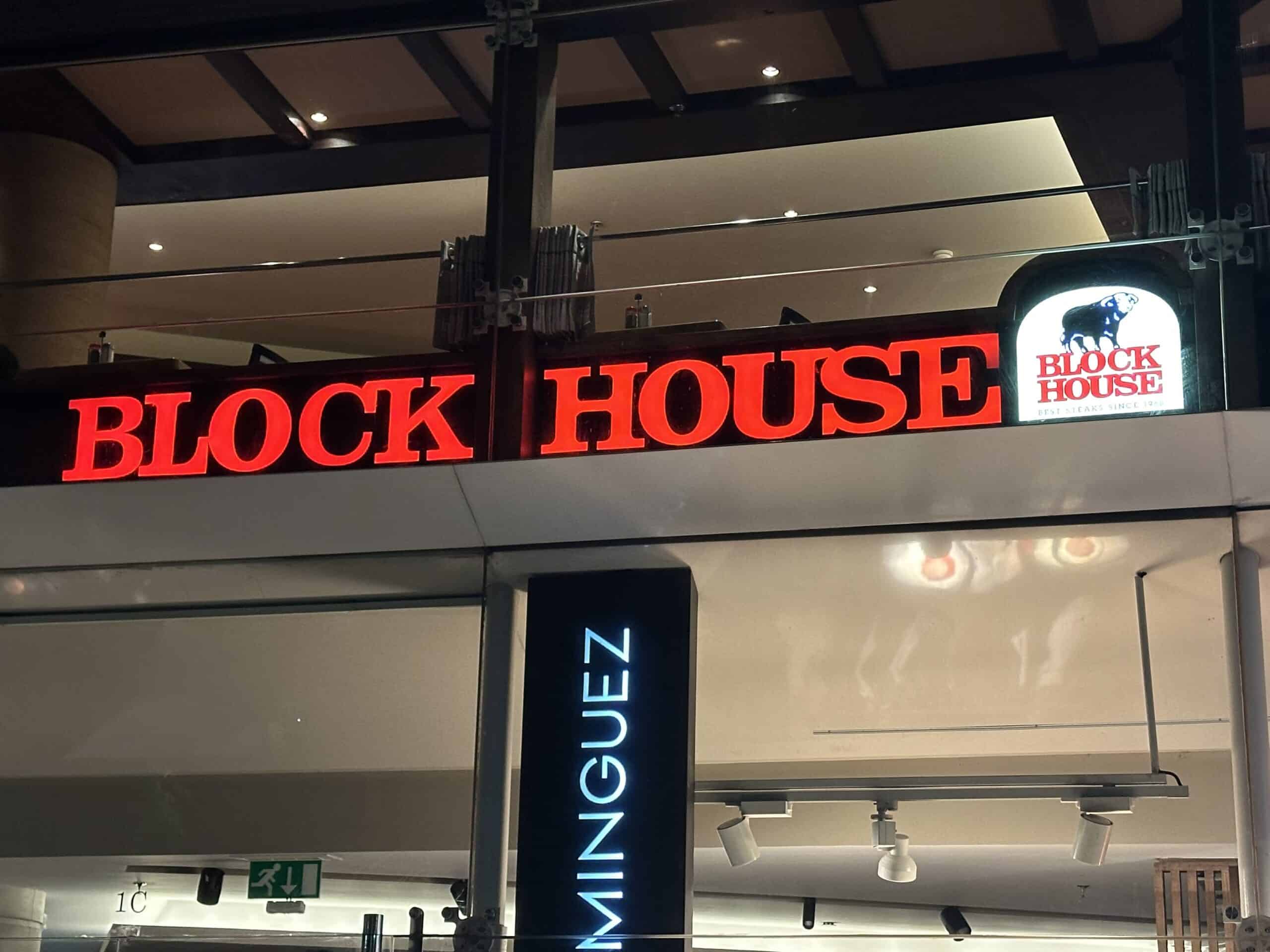
And also – a very Parisian looking metro station which I’m sure has an interesting story behind it…
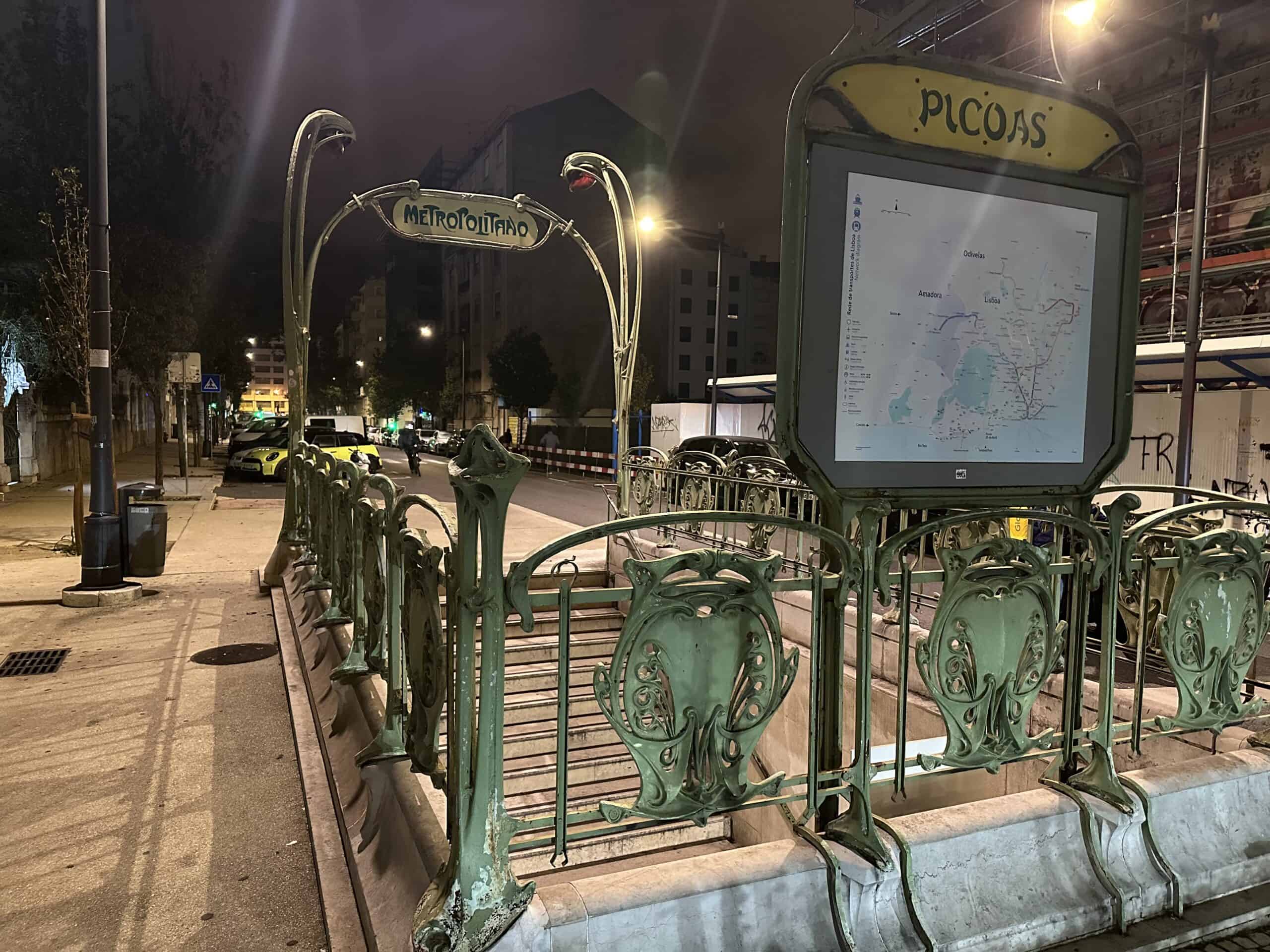
I arrived back at my hotel just before a quarter eleven, and an alert on my watch drew my attention to the fact I’d reached a personal best for exercise in a day – 242 active minutes. Looking at more detail, I’d done 27,884 steps – walking for 23 kilometres and had climbed the equivalent of 120 flights of stairs. It definitely felt like that!
I collapsed into bed. Hopefully the next day – my last full day in Lisbon – would be more relaxing!